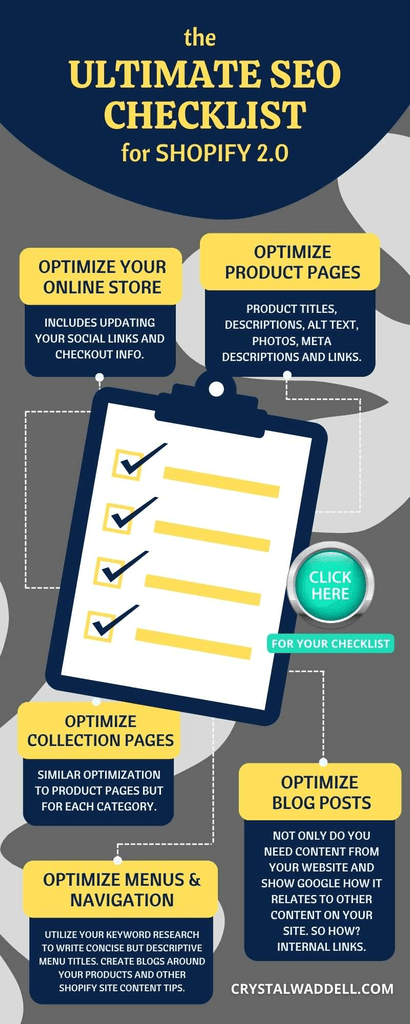2023 SEO for Shopify 2.0: The Ultimate 47-Point Checklist

SEO IS A TRICKY BEAST TO TAME.
It can be hard to know where to start, and even harder to know if you're doing it right.
That's why we've put together this SEO checklist for Shopify 2.0 themes.
If you want your shop to rank higher in search engine results pages (SERPs), then follow these steps!
SHOPIFY SEO TOOLS VS. MANUALLY MONITORING YOUR SITE SEO
Trusted names like Yoast SEO have now entered the Shopify app store. I'm a big fan of turning SEO signals green.
However, many Shopify apps will claim to help your Shopify SEO - but beware.
If you use some Shopify apps and then delete them, it can mean severe consequences for your store.
Like what, you ask?
If you delete a Shopify SEO app, you may also delete all the SEO work done on behalf of your Shopify website.
Fixed broken links, compelling meta descriptions, alt text?
They can all disappear faster than good pens at Pam and Erin's desk.
THAT'S WHY I CREATED THIS SHOPIFY SEO GUIDE ...
To give you the option to master Shopify SEO on your own - without Shopify SEO apps.
You don't need a plugin like Yoast SEO for Shopify. You can use an SEO monitoring tool like Ubersuggest or Ahrefs (for free!)
Or you can pay for an external app like the ContentKing App and track your SEO daily.
If you want to see the best Shopify 2.0 SEO resources in one place, then you’ll LOVE this Ultimate Checklist.
I reviewed every item on this list. (I'm a certified Shopify partner and I can create your Shopify website or install all of these SEO items!)
My suggestion:
if I mention something that jumps out to you and you feel the urge to put in place right away, DO IT!

And no shade if you feel like you prefer an app like Yoast SEO for Shopify!
Michael Scott might judge you, but I won't, I promise.
Finally, if you need to take a break (and you will!), you can always come back and pick up where you left off!
WHO THIS ULTIMATE SEO CHECKLIST IS NOT FOR:

So who did I not write this article for?
Dropshippers and e-commerce owners whose business depends on trending products and changing offers.
Recently, I spoke with a dropshipper who sells on Amazon and processes more than $20k per month in returns.
NO, THANK YOU!
WHO THIS ULTIMATE SEO FOR SHOPIFY CHECKLIST IS FOR:

ARE YOU AN ETSY SHOP OWNER TRYING TO EXPAND YOUR BUSINESS BEYOND ETSY?
Then this SEO guide is for you. If you manufacture your own products, this article is for you.
This Shopify SEO guide gives actionable advice if you sell online with a Shopify store.
You will begin to understand the infrastructure of a website. Then you can learn how to install search engine optimization (SEO) for your Shopify store.
That means you can build your online empire with confidence. (And get your website discovered by Google search and more!)
If you have not opened your Shopify store, this guide will help you prepare your SEO strategy.
If you're my perfect reader, you'll have a product you manufacture and a no-returns, no refunds policy.
This SEO checklist will guide Shopify sellers to find keywords that support your pillar products.
Let's jump in!
-
Keyword research - What do you want to rank for?
-
Choose and customize your Shopify 2.0 theme.
-
Upload only images optimized with related keywords.
-
Add Image Alt text
-
Customize Theme - Social Media
-
Customize Theme - Add Favicon
-
Checkout Options - optimized banner image
-
Checkout Options - optimize logo file

-
Product Title Tag (Include target keyword)
-
Keywords In Description
-
Keywords in Image Names
-
Keywords in Alt Text
-
Make sure Image Sizes are 1000x1000 - 1400x1400.
-
Product Page title with keywords
-
Write a good meta description with keywords
-
Product URL with keywords
-
Add Internal links

-
Collection Title tag
-
Collection Description
-
Collection Page title with keywords
-
Collection SEO descriptions with keywords
-
Collection URL with keywords
-
Collections Page Image - Optimized Image File
-
Add Internal Links
-
Blog Title with keyword(s)
-
Blog content that includes keywords AND links
-
Blog excerpt with keywords.
-
Blog to build authority around your product pages.
-
Blog Images Optimized with keywords.
-
Blog page title with keywords
-
SEO descriptions with keywords
-
Blog URL with keywords
-
Double check for internal link building opportunities
-
Will you have more than one blog?
-
Page Title with keyword(s)
-
Content with keywords
-
Page SEO title with keywords
-
Page descriptions with keywords
-
Page URL with keywords
-
URL Redirects
-
Editing Menus (and adding keywords)
-
Shopify Search and Discovery App
-
Homepage Title Shopify Examples
-
Homepage Meta description tag
-
Social Sharing Image Preview
-
Google Analytics
-
Spam Protection
THIS ARTICLE DOES NOT COVER SHOPIFY STORE TOPICS UNRELATED TO SHOPIFY SEO
This includes sourcing products and purchasing domains.
Additionally, we will not discuss setting up payments or other ecommerce platforms like WooCommerce.
For Shopify owners ready to move forward, let's get ready to improve your Shopify SEO!
HOW TO USE THIS CHECKLIST TO IMPROVE YOUR SHOPIFY SEO
Find one piece of SEO you can improve today, stop reading, and update your Shopify store.
Then come back to this Shopify SEO guide. I'll be here!
SEO is a repetitive process. It's a process with a lot of twists and turns. Which means, some days you may want to focus on optimizing product pages. Other days, blog posts.
I'll give you my best SEO tips that I use for optimizing each section of your site.
No matter the type of web page, will assign that page a job.
We will also assign each page a target keyword for which we want that web page to rank.
At the end of the day, we are writing for people AND for Bing Webmaster Tools and Google crawlers.
Search engine optimization for your Shopify store is a lot like eating an elephant. The good news: we can eat this elephant together, one bite at a time.
Got your fork? Let’s eat!
PART 1: SHOPIFY WEBSITE SEO CHECKLIST - ONLINE STORE

1. KEYWORD RESEARCH
The key to getting discovered in search queries? Understanding what words shoppers use to find your products.
When you're setting up a new Shopify store, think about what people might be searching for online.
This will help people find the content you create. A fancy word for this: keyword research.
Create your list of keywords. Then add the keywords to collection pages, product pages, and blog articles.
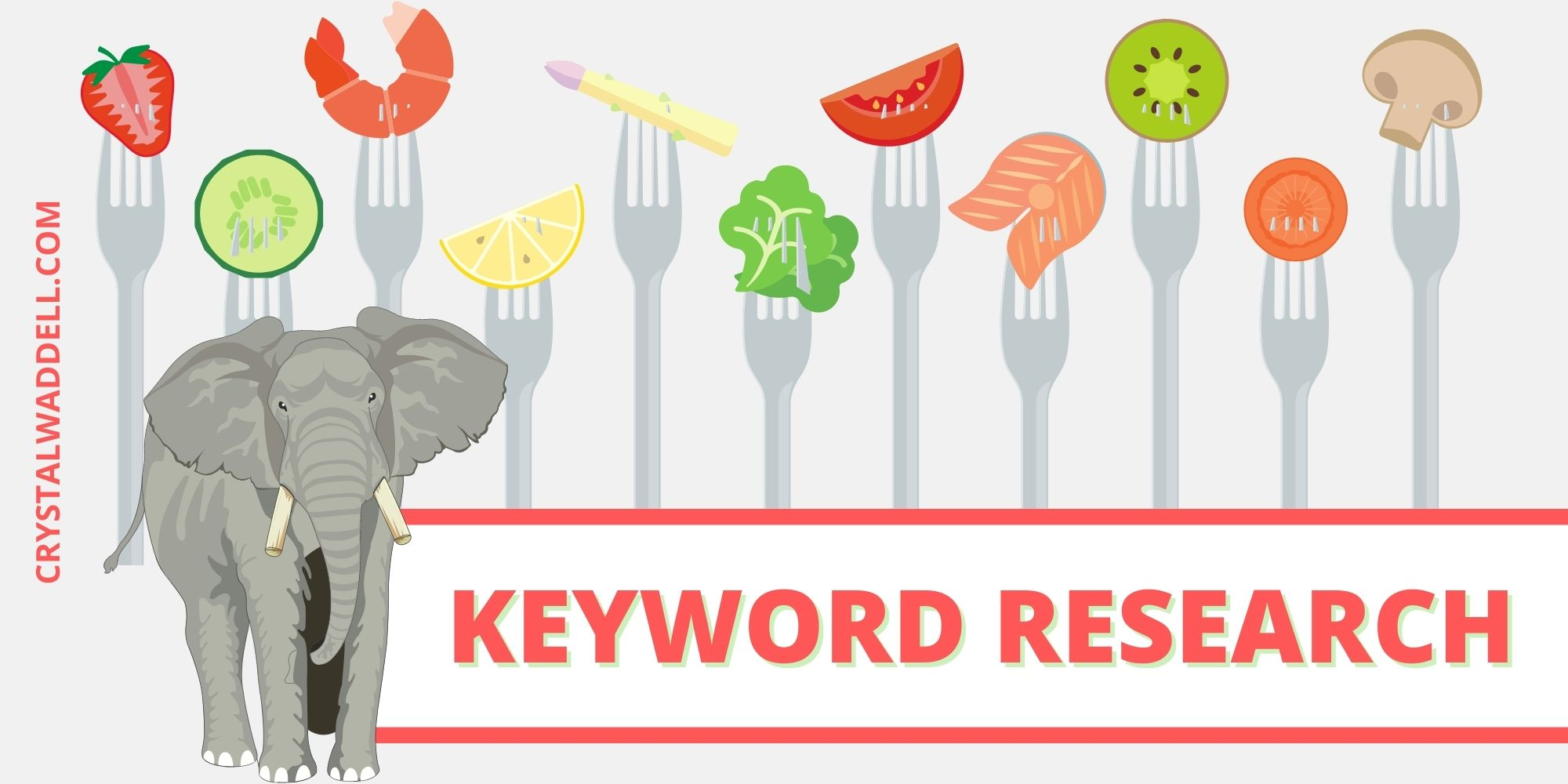
KEYWORD RESEARCH IS THE FOUNDATION OF A SOLID SHOPIFY DIGITAL MARKETING STRATEGY
For example, in my ecommerce store CollageandWood.com, I sell giant photo collages.
Most people don't search "photo collages." They search something like "pictures on wood."
These words of the customer become target keywords.
Include your target keyword terms in your product descriptions.
Use the words everywhere you can on your website so that customers can find what you sell.
The easiest way to do this? Use a keyword research tool.
2. CHOOSING A 2.0 SHOPIFY STORE THEME

When you choose a new theme or start a new store, you might notice that the default option for 2.0 is the Dawn theme.
I started using the Dawn 2.0 for my Shopify store but I prefer using a theme like Craft 2.0 or Studio 2.0.
There's more options, such as a favicon.
To choose your free 2.0 theme, click on "Explore Themes" and choose the theme you prefer.
After clicking "free themes" you'll get a pop-up.
Scroll through the selection to choose a new 2.0 theme for your new Shopify store.
Choose your theme and let's get started optimizing your Shopify SEO!
3. UPLOAD ONLY IMAGES OPTIMIZED WITH KEYWORD TERMS
You want your site to have a beautiful design.
You must capture your site visitors attention with bright pictures. You need compelling product page descriptions.
But to get found by Google search crawlers, you also need strong Shopify SEO practices.
Let's talk about how to use search engine optimization to help your online store IMAGES get found in search.
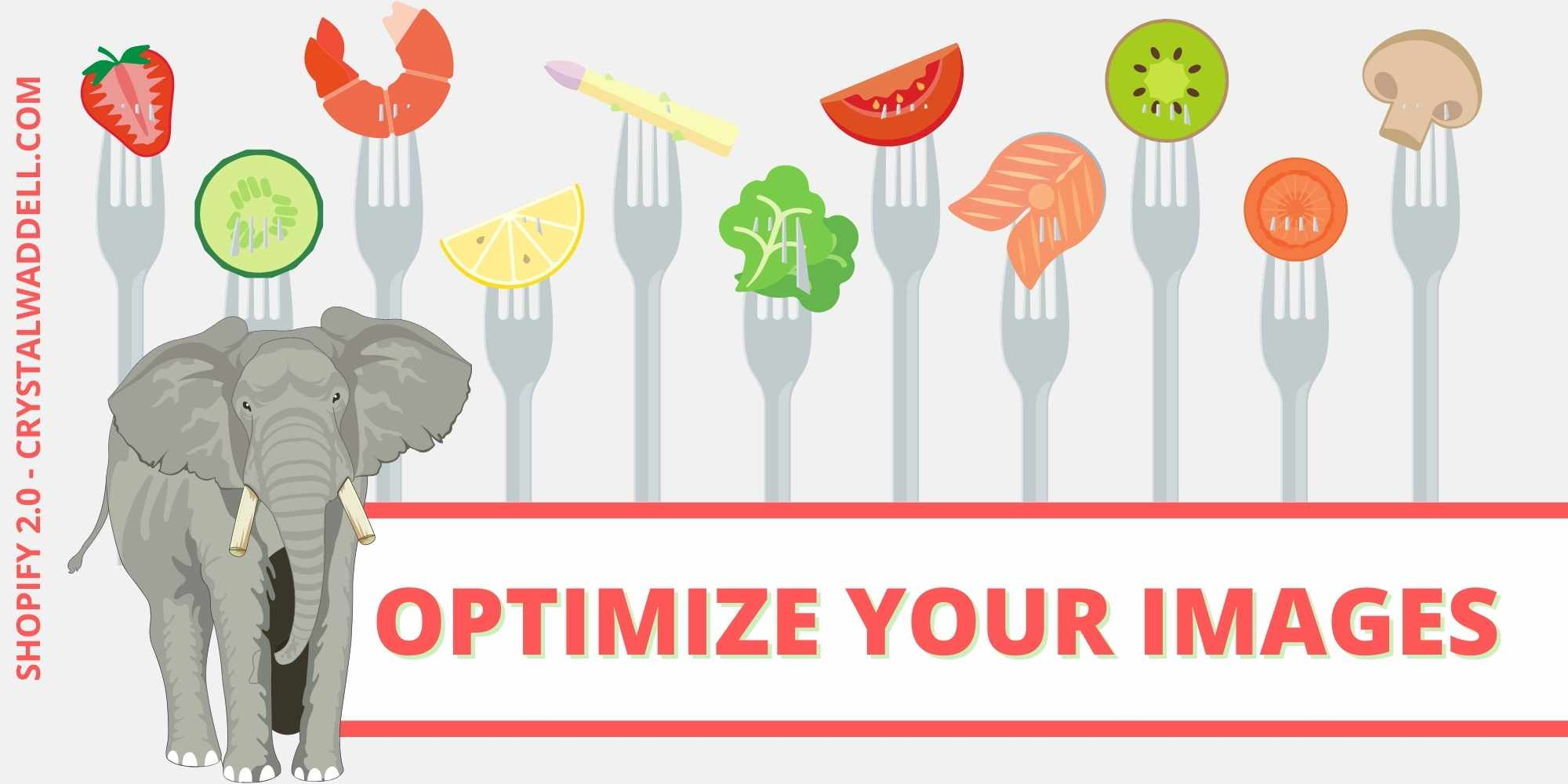
I've been guilty of making this mistake: forgetting to optimize Shopify image file names.
For instance, when you upload an image file to Shopify, it may say something like: img340.jpg.
Which most new Shopify store owners wouldn't think twice about.
Yet, when you optimize an image for Shopify SEO, you want the product title in the file name.
If I'm selling a wooden number seven, I would research what keywords people use to find a wooden number seven.
According to Keywords Everywhere, the number of monthly searches (30) isn't very high for the term "wooden number 7."
The number of monthly searches are much higher for "wooden numbers" (2,400 per month.)
So I would name the image file wooden-numbers-7.jpg to maximize product visibility.
The other part of optimizing an image is making sure that it's not a huge file.
Shopify product images can be as large as 2400x2400 but you want images to load as fast as possible for mobile.
Optimizing for mobile site speed is important, so try to keep images around 1000x1000.
4. ADD IMAGE ALT TEXT
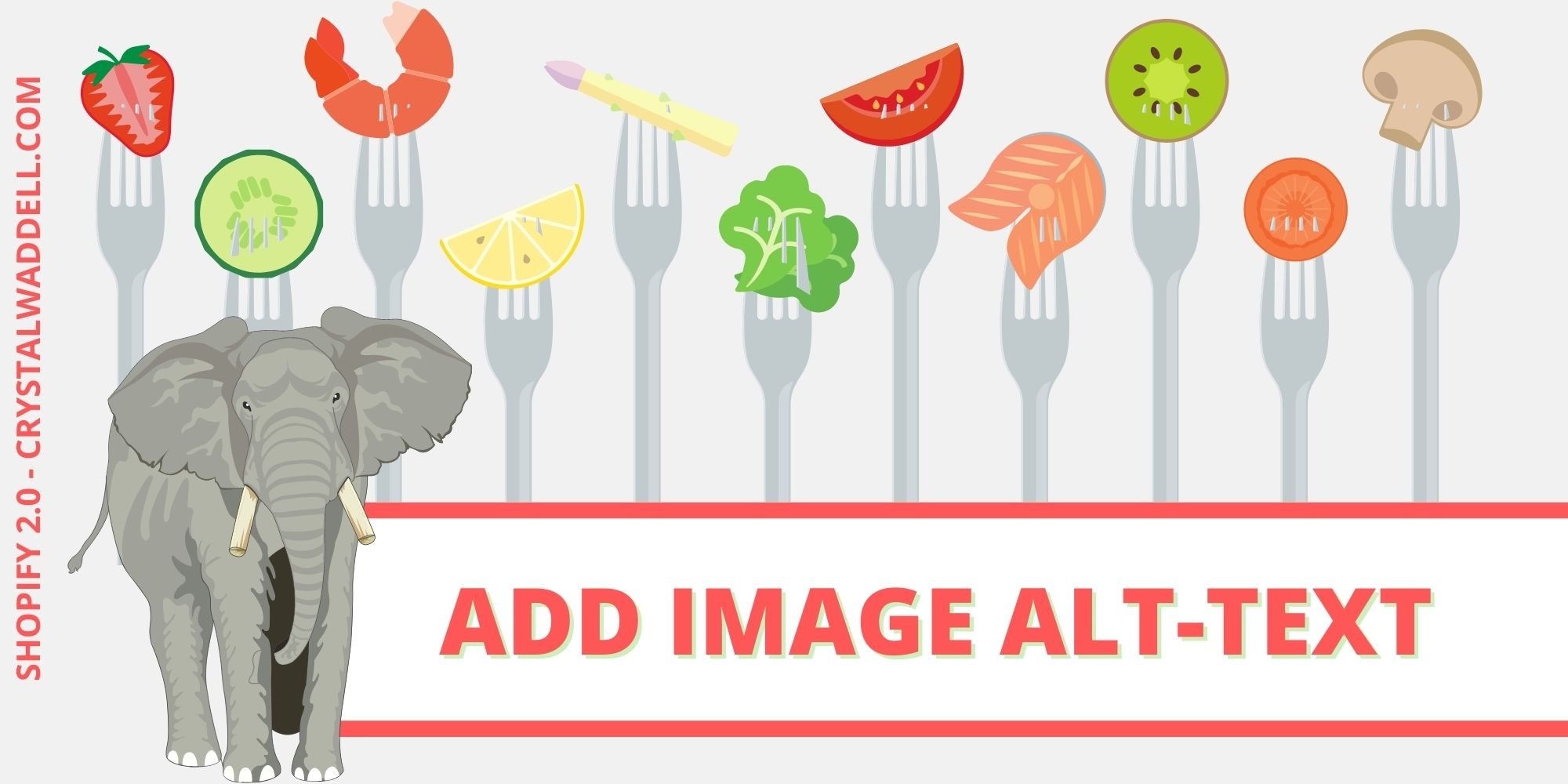

Search engines understand that some people with vision impairments use their search tool.
So they came up with alt text, a way to describe what's in the picture to those who can't see it.
It's also helpful for the times that an image doesn't load.
Alt text is also a great place to place important keywords that describe your image. It's descriptive, accessible, and SEO friendly.
Win - win- win!
5. CUSTOMIZE THEME- THEME SETTINGS
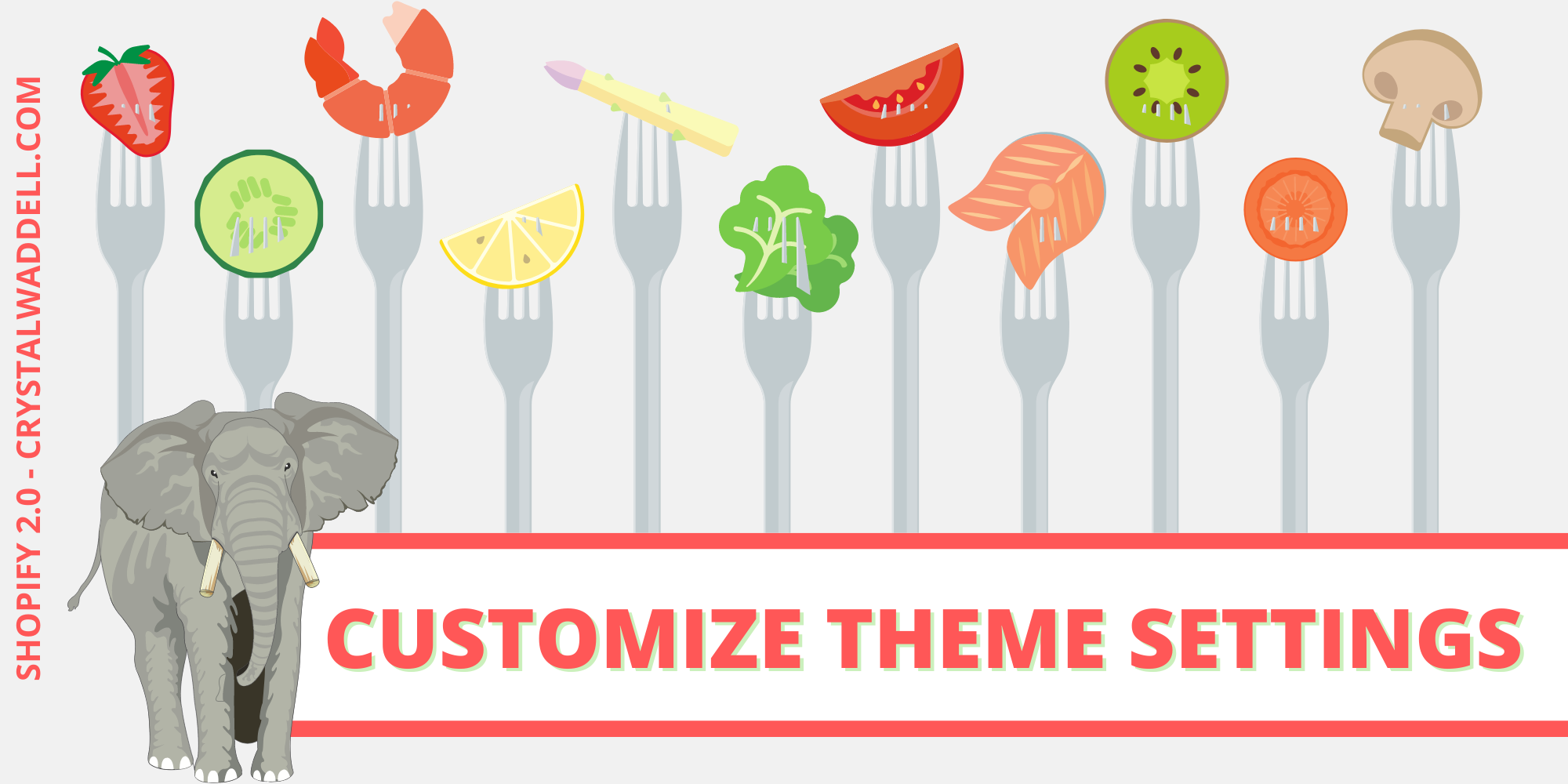
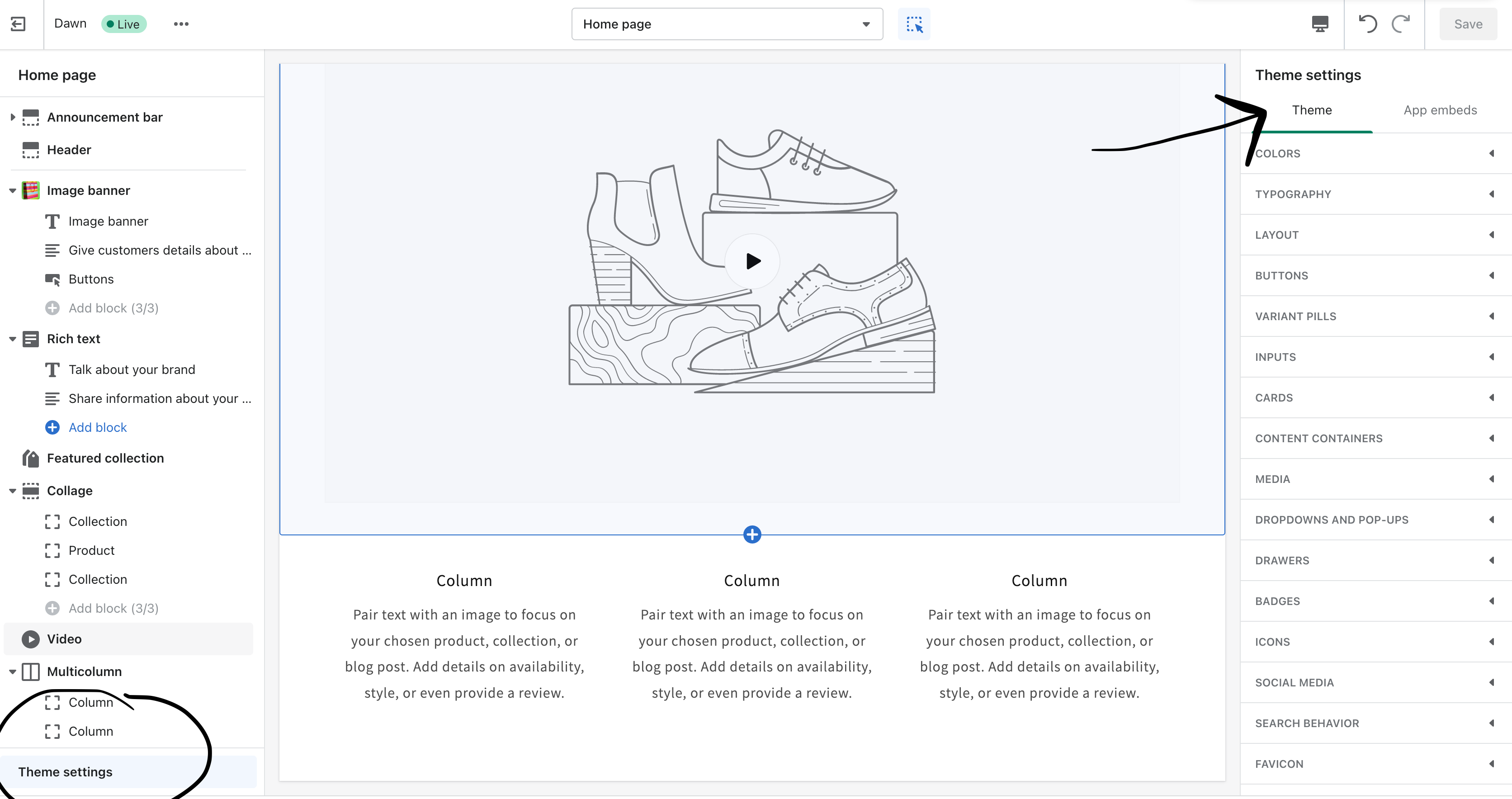
The theme settings on your Shopify site are full of SEO features.
You can update all your social accounts in one place!
Linking to social media platforms like Twitter and Linkedin is good for your website SEO.
All Shopify stores can drive organic traffic from social to sell online. Use all the free tools!!
6. UPLOAD YOUR FAVICON
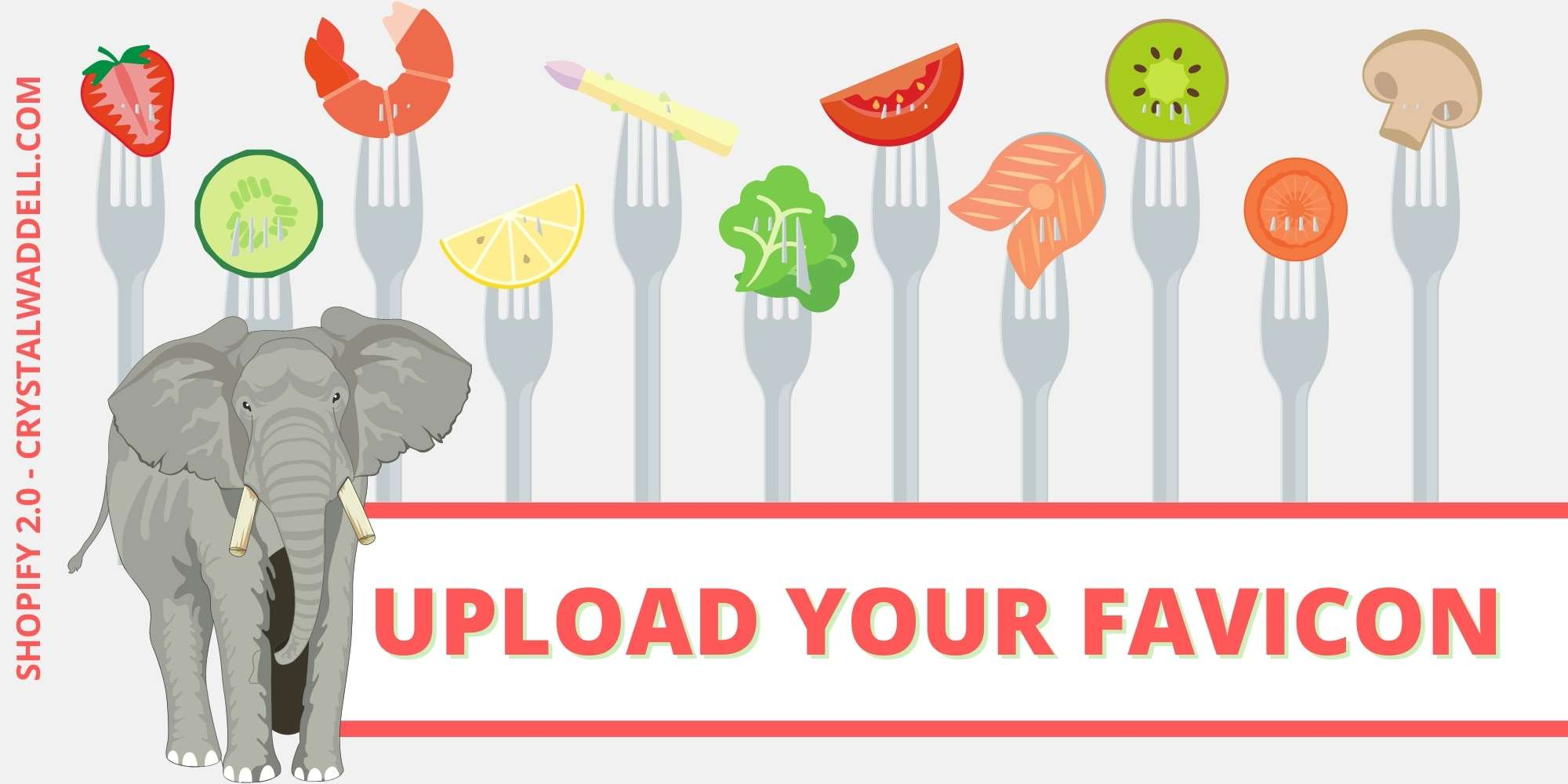
The other hidden SEO gem on this page is the Favicon.
In the initial release of 2.0 themes (like Dawn) the favicon was not available.
But in later themes, you can upload your favicon!
You create a small, square representation of your logo and it will show up next to your domain name in the search bar.
This helps differentiate your website from other websites.
You can brand your website by using a small graphic in the corner of the search bar.
When someone finds your website from organic search, favicons boost your site's credibility.
Here's an example of my Shopify ecommerce favicon in the search bar:

7. CHECKOUT OPTIONS - OPTIMIZED BANNER IMAGE
Uploading a banner image for the checkout page is an option but not a rule. Shopify recommends an image that is 1000x400.
In my stores I have found this image a little distracting, so I do not use it.
Additionally, these pages are not indexed by Shopify. So there isn't a lot of SEO value.
But, if you use the image options, optimize them so that you keep your procedures consistent.
8. CHECKOUT OPTIONS - OPTIMIZE LOGO FILE
Utilizing a logo file here is great.
Seeing a familiar logo builds comfort and trust in a client's mind.
There is little value here in SEO for Shopify because these pages are not indexed for search.
But, there is an important takeaway: always include keywords in the name of your logo file.
Logo files can show up as an image search result in Google searches.
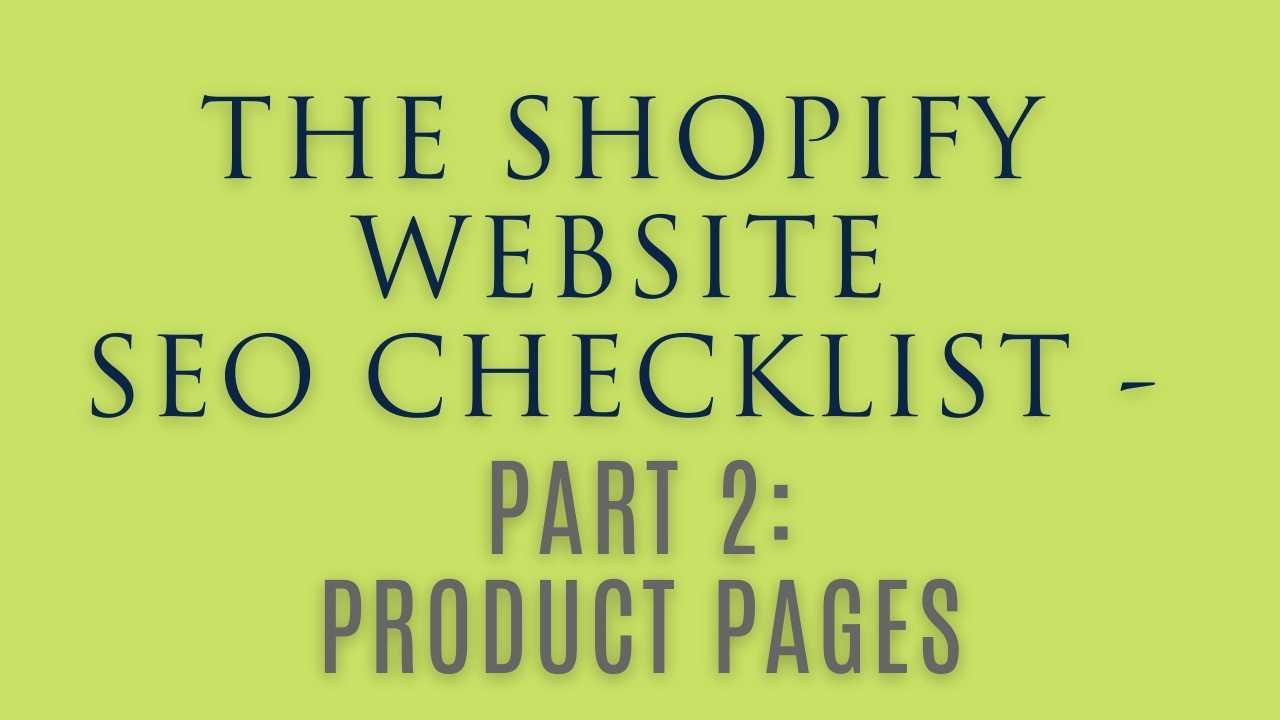
9. PRODUCT TITLES
Write product titles like you would write titles for blogs.
The SEO principles are the same. Your title will show up in the search engine listing preview.
The goal is to make it descriptive and clear and get potential clients to click on your search results.
Place keywords towards the front of the title.
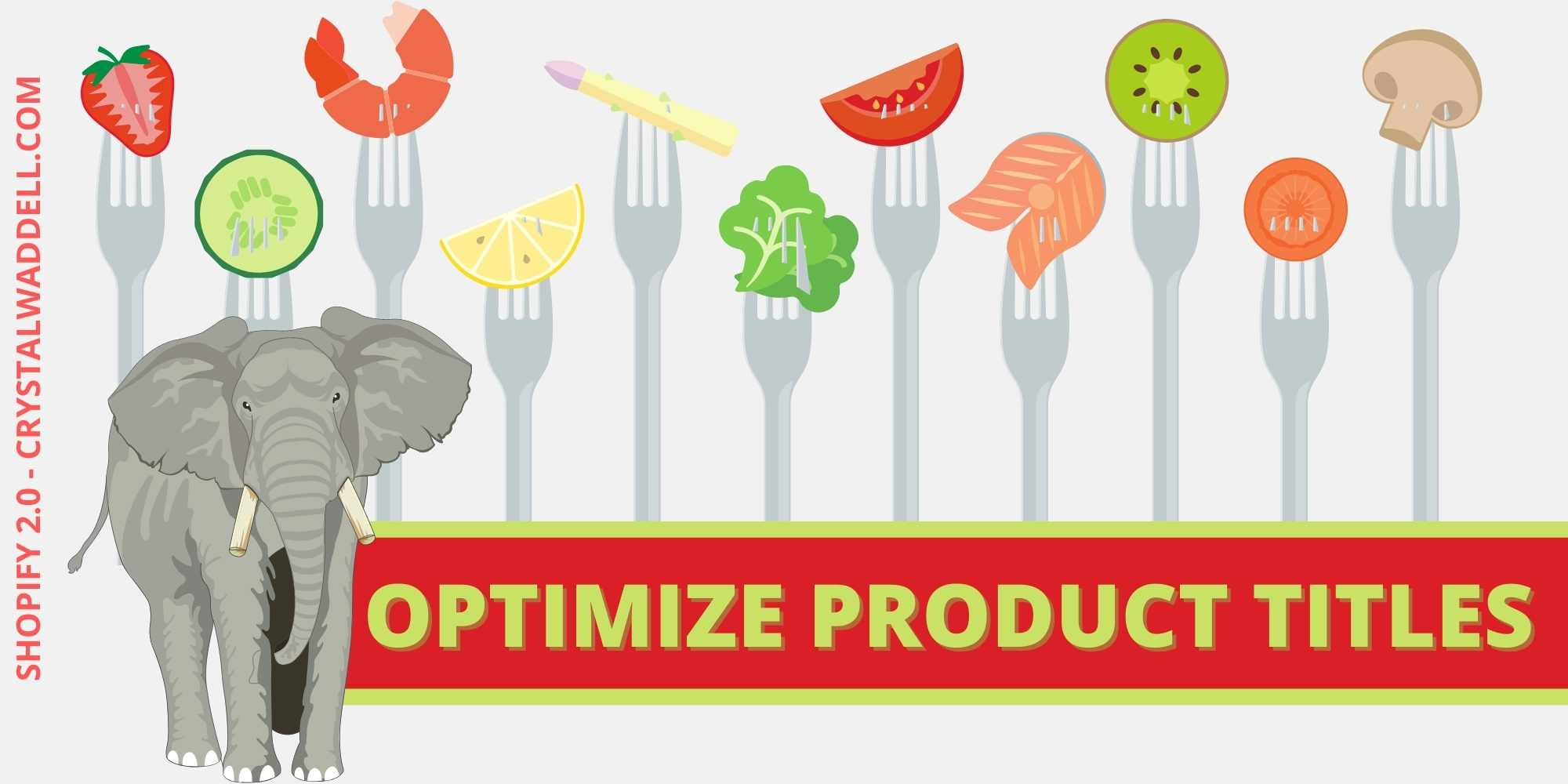
Make sure your titles are interesting, unique, and informative.
I use the Ahrefs free site audit tool to analyze all title tags on my Shopify site, including product pages.
Here are a few tips for writing title tags for your Shopify products:
- Use your primary keyword in the beginning of the title.
- Keep it short and sweet. Aim for 50-60 characters.
- Write for your audience first, search engines second.
- Make sure your title reflects the product page content.
- Use unique titles for each product page.
This effort can help your pages stand out in the search results and earn a click through to your site.
10. KEYWORDS IN THE PRODUCT DESCRIPTION
A common mistake many Shopify store owners make involves product pages.
This mistake: duplicating a product page to save time creating them.
Which creates duplicate content.
Unfortunately, this will cost you more time in the long run.
According to Semrush expert Greg Gifford, Google doesn't punish you for duplicate content.
Google REWARDS you for original content.
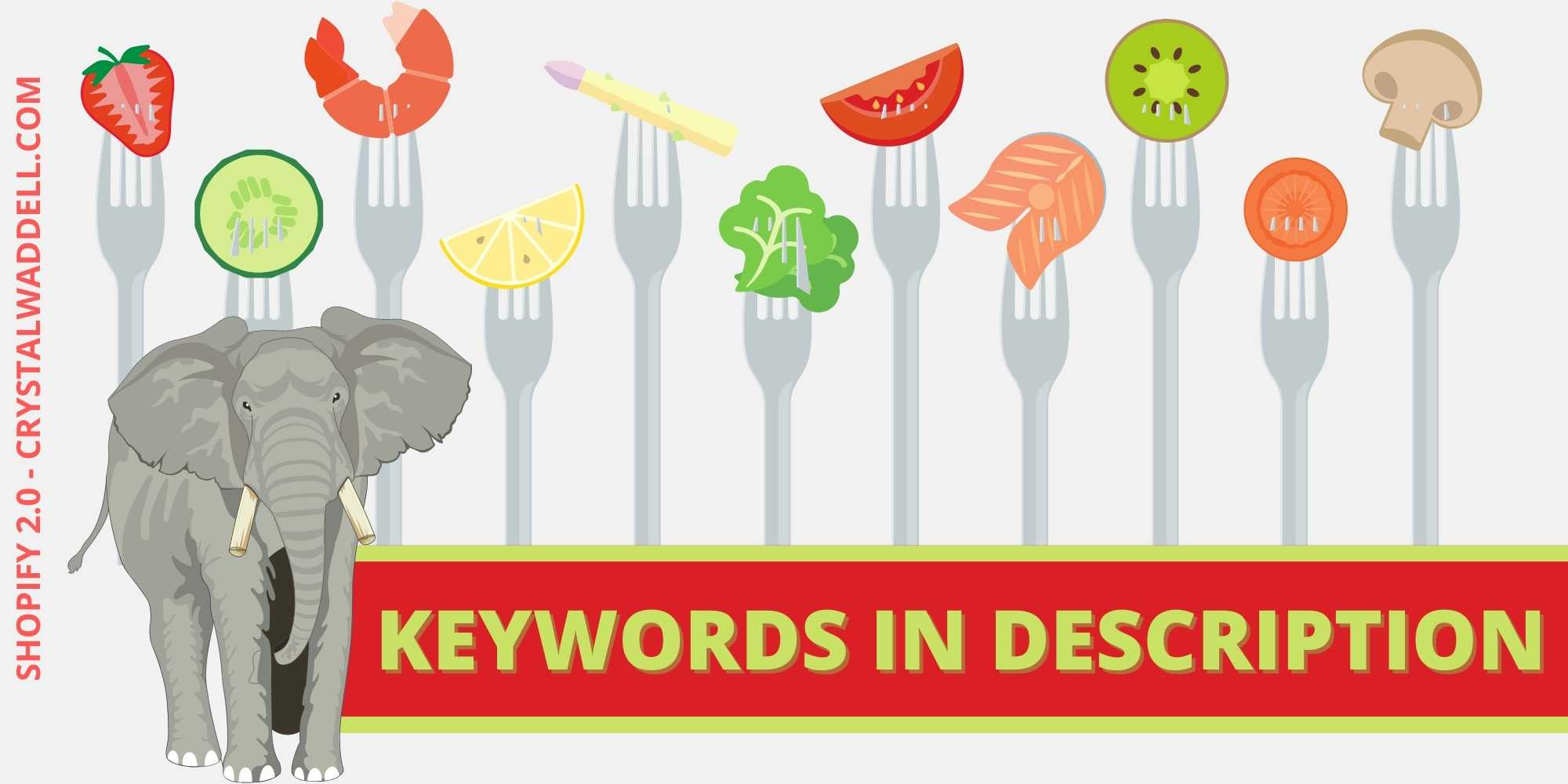
There's several ways to enhance the content on your product descriptions.
I utilize an ai copywriting tool to help write interesting and unique descriptions.
Go beyond the simple and boring, "this is the color and the size and the material."
Use clear, descriptive language. Allow your your customer to see herself enjoying your product.
Save the boring (but necessary) stuff like shipping and sizing for metafields.
11. KEYWORDS IN IMAGE NAMES
Image file names is another often missed opportunity for keyword placement.
Changing a filename from DSC4567.jpg to blue-widget.jpg can make a difference in your SEO.
You may show up in Google IMAGE search results for the product you sell!
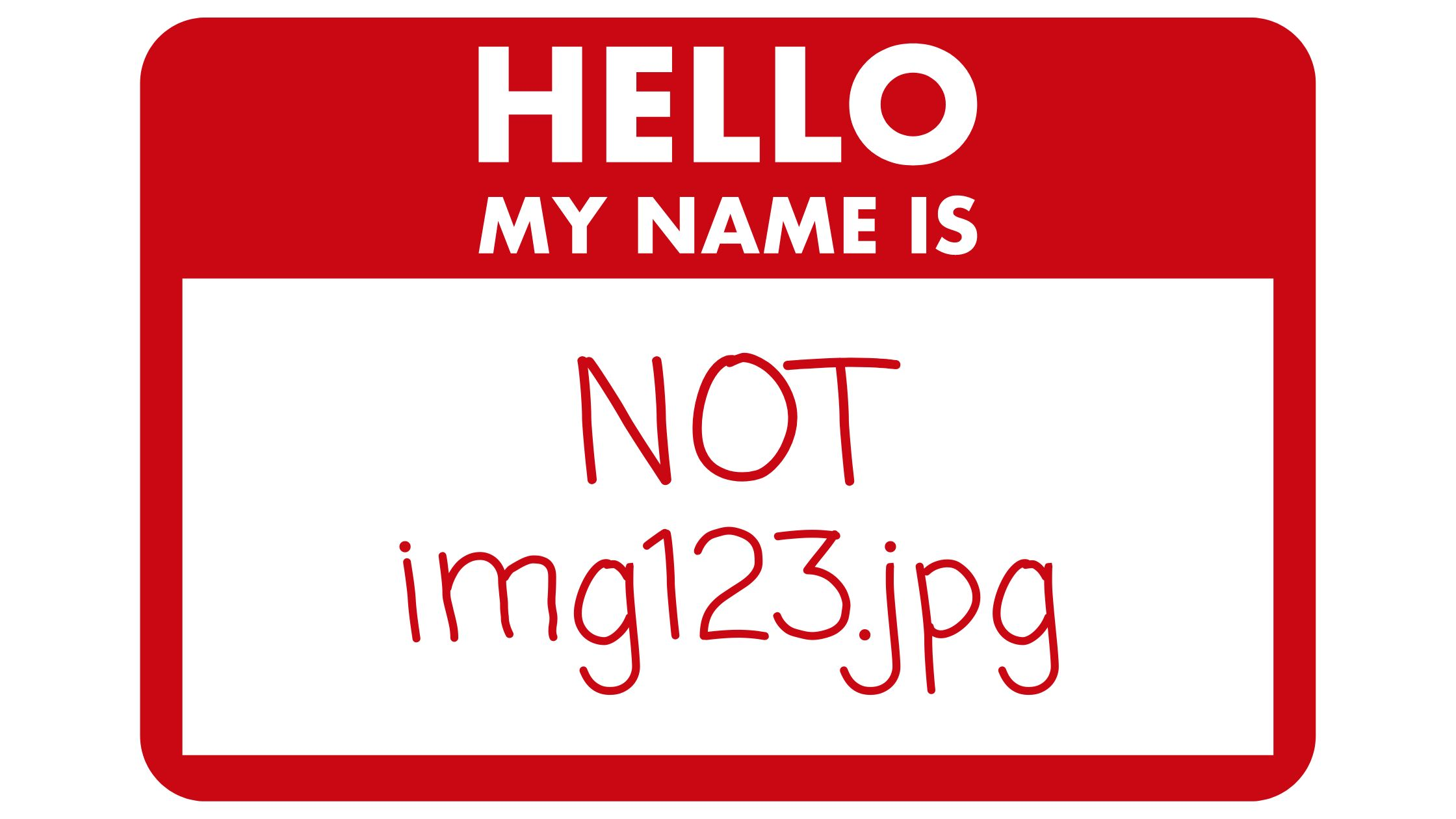
Follow these image publishing guidelines from Google:
-
Include descriptive text. Include text somewhere near the image, like an "alt" tag or a caption. This helps Google understand what the image is showing and what searches it relates to.
-
Upload high-quality photos. Great image content is an excellent way to build traffic to your site." - Google.com
Balancing high quality photos with site speed is challenging but important.
The good news is, you can edit every product photo after you upload it and adjust the size. The option to do so is in the lower left-hand corner of the image edit screen.
Finally, be patient. Images you upload to your own website won’t magically appear in search results.
You’ll need to wait until Google indexes your site before your images show up.
You can force-index a new page by using Google Search Console to submit an updated or new URL.
12. KEYWORDS IN ALT TEXT
Include keywords in the alt text of your images throughout your Shopify site.
This includes images within your product descriptions. This helps search engines understand your images and index them.
Again, this provides a better experience for those who may be using screen readers.
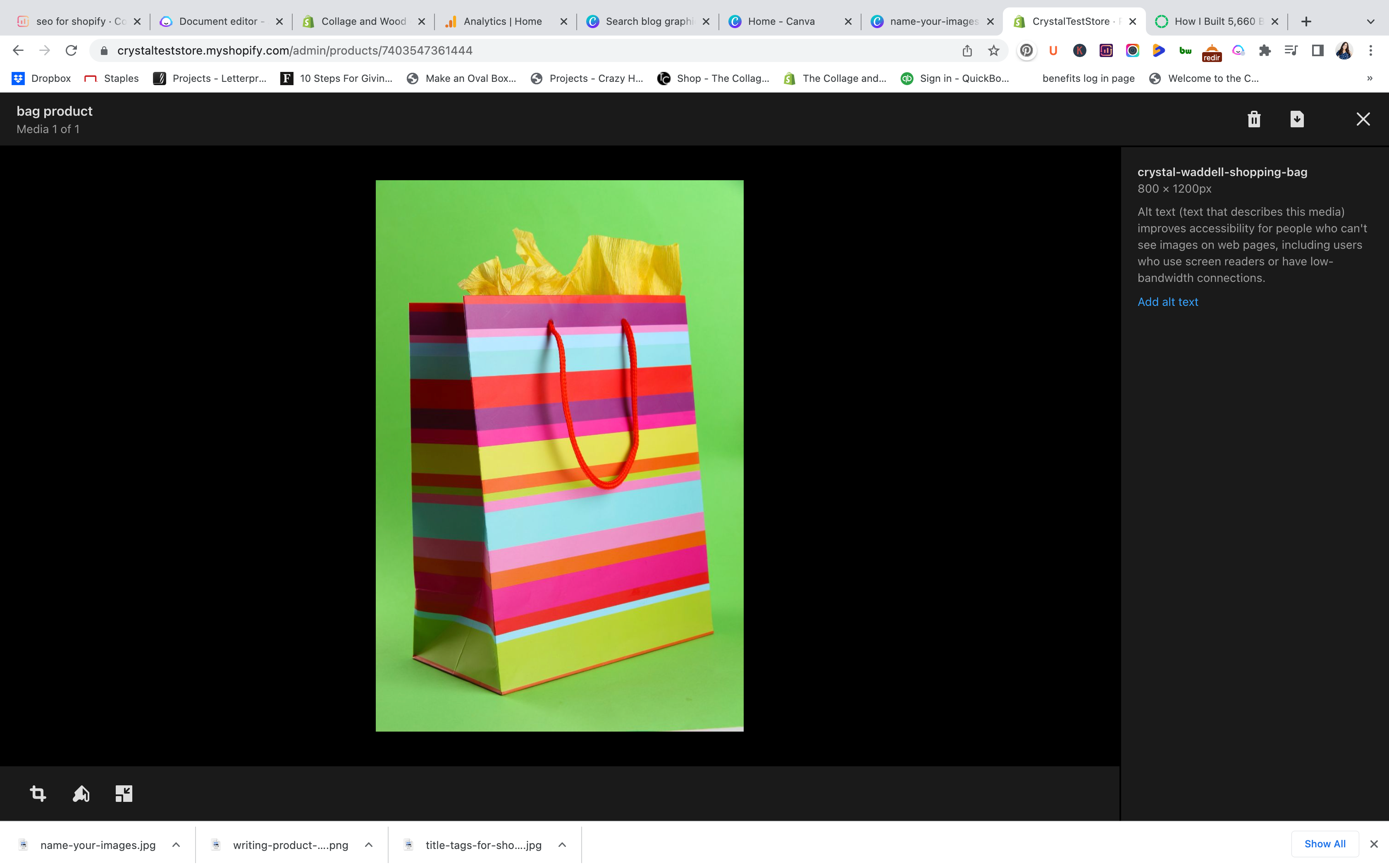
To optimize the alt text of your images for SEO:
-
Make sure the alt text is descriptive and includes keywords relevant to the image.
-
Avoid using generic phrases like "image" or "photo".
-
Use different alt text for each image on your site. Resist the urge to copy and paste!
Following these tips will help you create better alt text for your images and improve your SEO.
13. OPTIMIZE IMAGES TO LOAD FASTER
Images are an important part of any website, and that’s especially true for ecommerce sites.
Product pages need high-quality images that load fast.
Long page load times result in customers leaving your site and shopping somewhere else.
Third-party Shopify apps may overwrite your alt tags to improve your SEO.
Buuuuut - you risk the chance of losing their "optimization" if you change apps in the future.
This is because some apps "cloak" your site with SEO upgrades but it's not actually on your site; it's within the app.
That's why I'm a fan of utilizing a free tool like Ahrefs.
It may be a little harder on the front side, but you remain in control of your SEO.
14. PRODUCT PAGE TITLE WITH KEYWORDS
Including keywords related to the product will help potential customers find products in your Shopify store.
Suppose you sell red running shoes.
Some possible keywords could be "shoes," or "running shoes," or "red running shoes," or "women's running shoes."
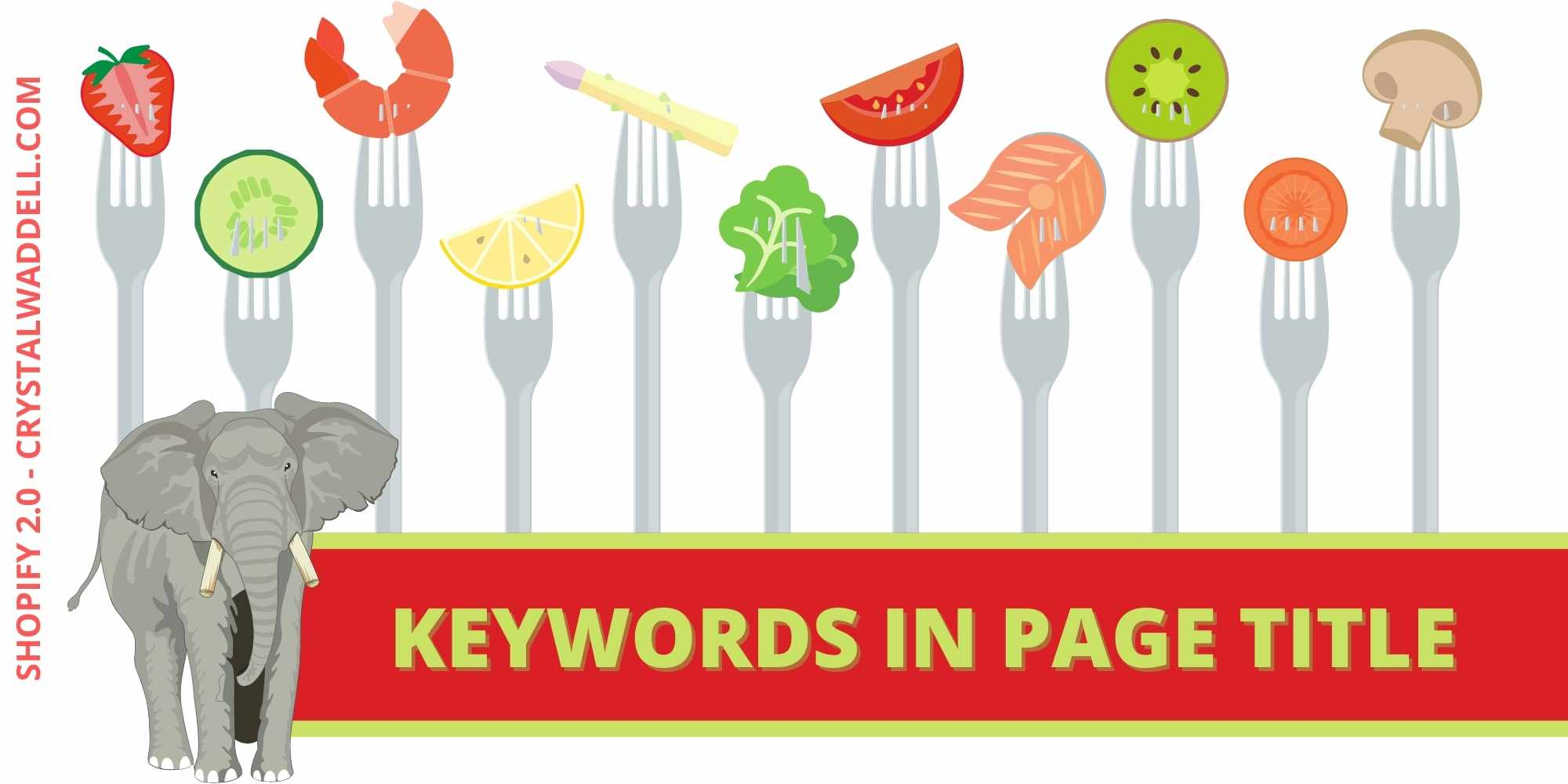
Keep in mind product titles and page SEO titles should align.
Page SEO titles should be between 50-60 characters in length.
This means your product title can be descriptive. Keep your main keywords at the front of the title.
Here's an example: Red Running Shoes: A Perfect Way to Add Pops of Color.
15. WRITE COMPELLING META DESCRIPTIONS WITH KEYWORDS
When it comes to Shopify, using keywords in each meta description is a great way to help improve your site's SEO.
This is because search engines will use the information in your descriptions to help determine the relevance of your site to potential customers.
And your customers may see this little tidbit of information and realize you have the solution for them. Which means a click for you!
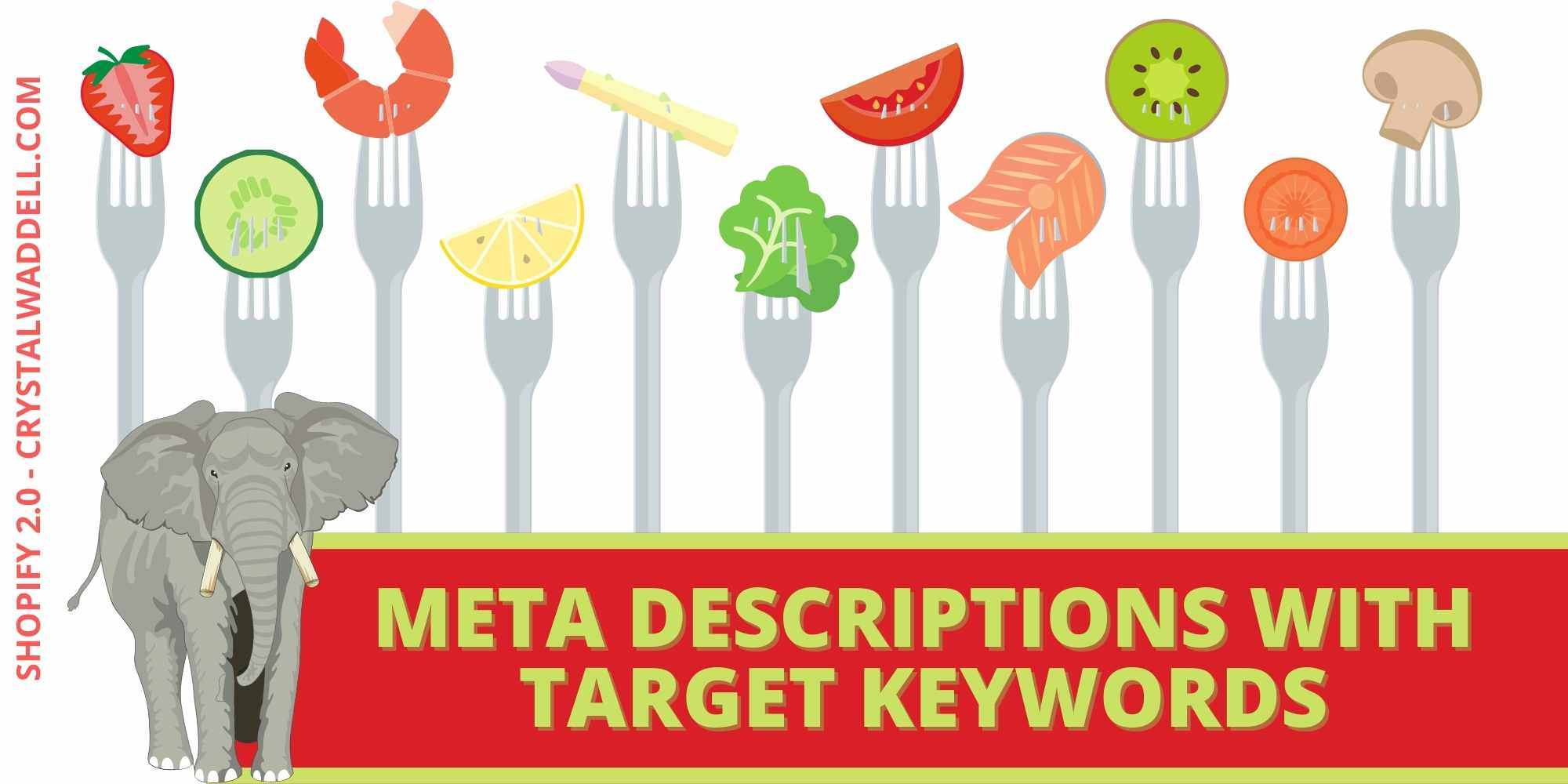
Relevant keywords in your descriptions gives your site a chance to show up one of the top results.
Writing a great meta description also helps you show up as an answer to a googled question.
Which is a reassuring referral to potential customers!
16. INFUSE YOUR PRODUCT URL WITH KEYWORDS
Include keywords in the URL to help improve your product's ranking on search engines.
The keywords in URL slugs help customers searching related terms find your product.
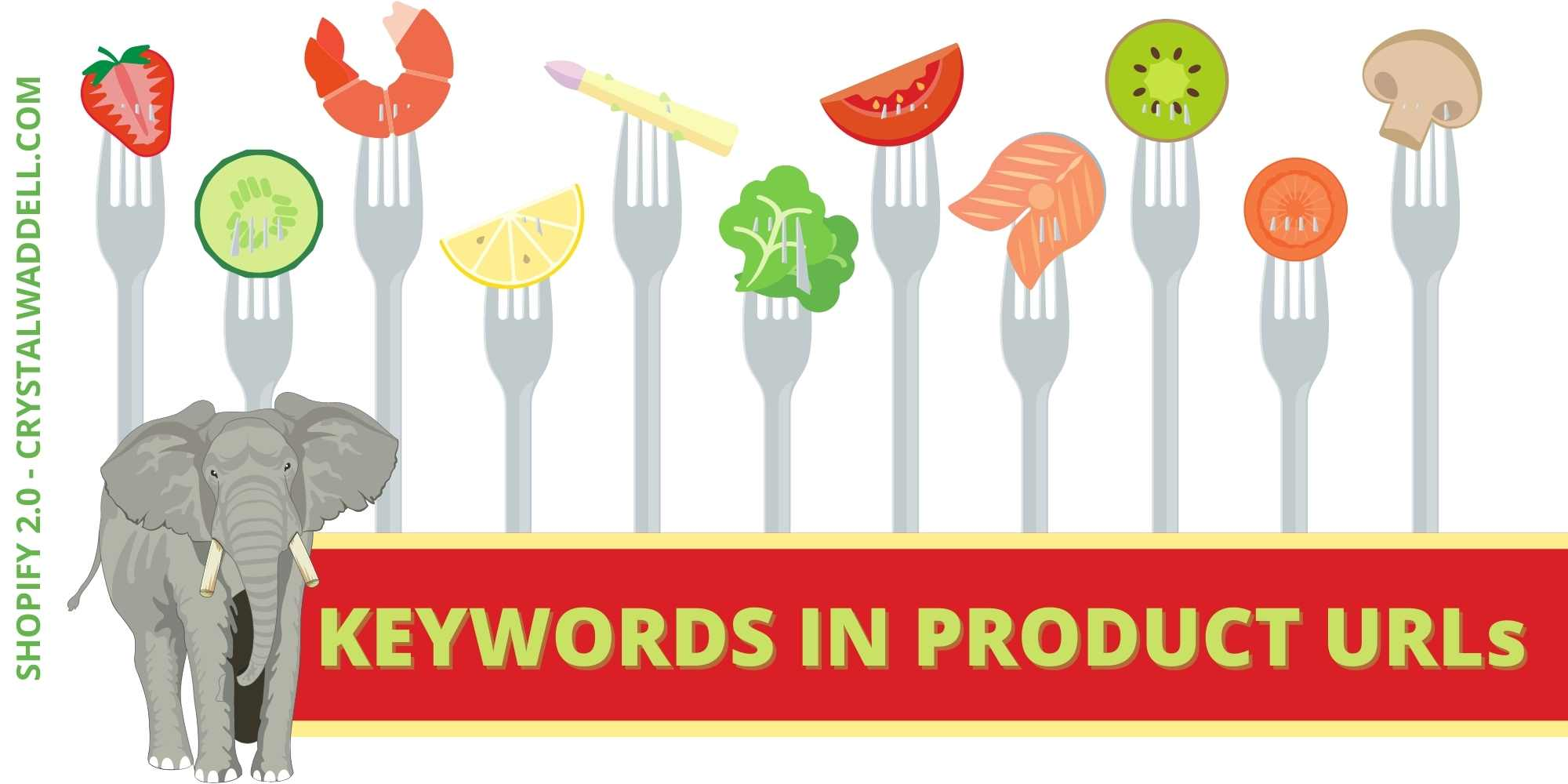
When creating your product's URL, be sure to keep the following best practices in mind:
- Use keywords that are relevant to your product.
- Keep your URL short and easy to remember.
- Use hyphens to separate words in your URL.
- Avoid using special characters or spaces in your URL.
Some mistakes I've made utilizing keywords?
- Not using the words my customers use (keywords) in the URL.
- Not understanding WHY they were searching (search intent).
Clients will find your product when you align your keywords with search intent.
17. INTERNAL LINK BUILDING
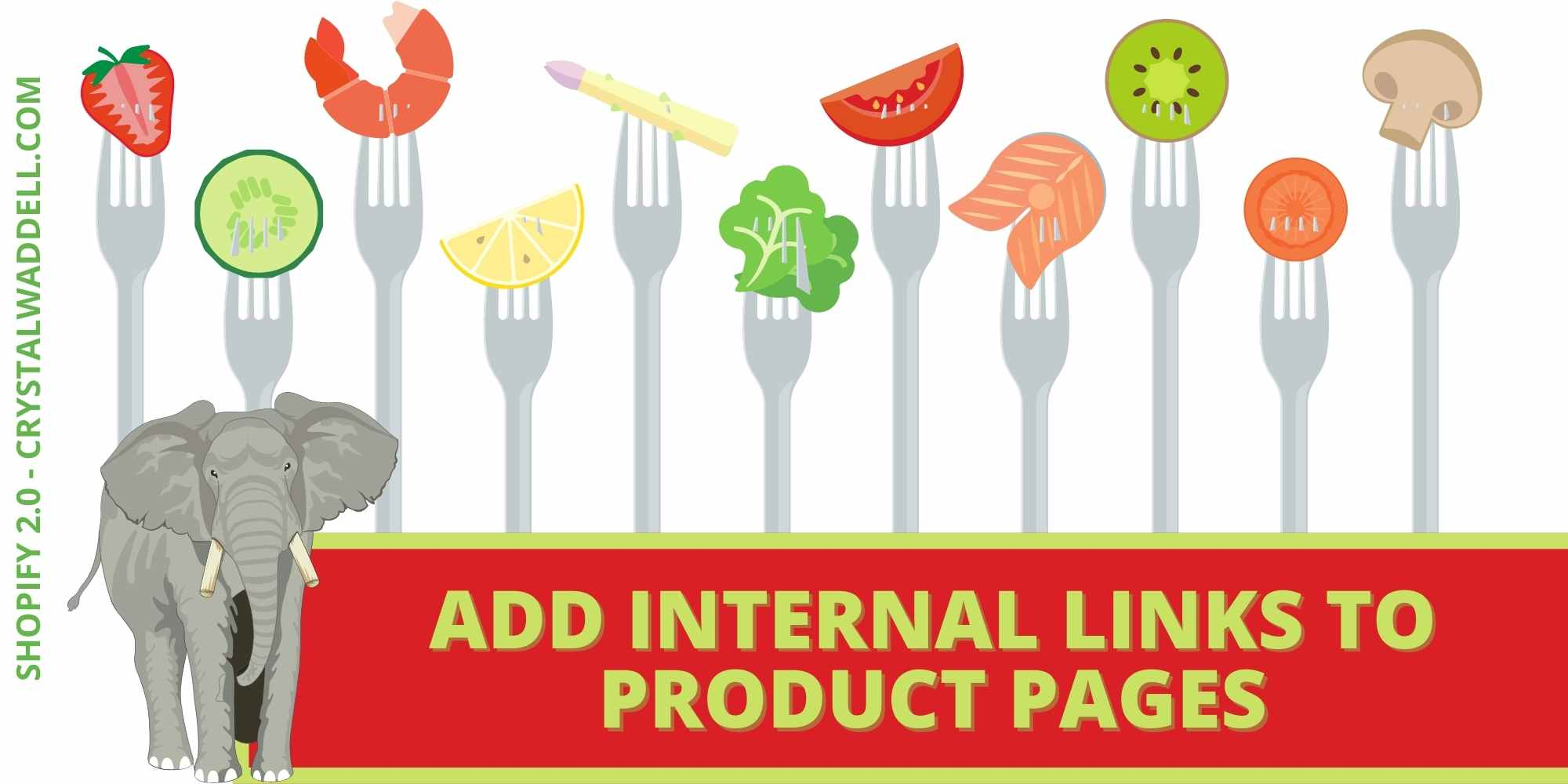
Internal links containing your target keywords will help search engines understand your page.
Keywords should describe your products, which makes internal link building straightforward and simple.
All you need to do is write about your "red running shoes" and link to your product: red running shoes.
This can help your page rank higher in search engine results pages for those keywords.
Also, internal link building can help keep visitors on your site longer.
They'll feel comfortable navigating your site.
Engaged visitors may click available links on your store that are relevant to the topic they're searching.
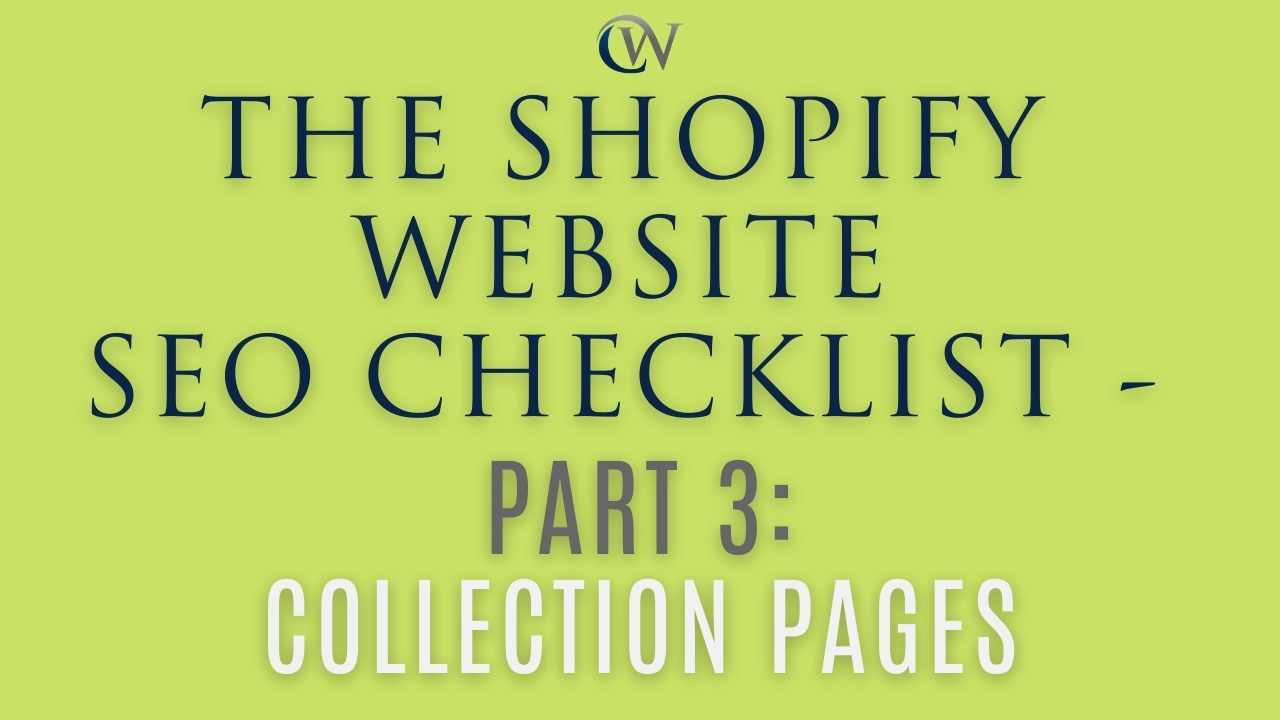
18. COLLECTION TITLE TAG
The catalog title tag is one of the most important on-page elements for SEO.
It tells Google and other search engines what your page is about. The title tag is one of the on-page SEO factors Google uses to rank pages in search results.
A well-optimized catalog title tag helps you rank higher. Which means better traffic to your store.
And better traffic means more sales and more profits for your business.
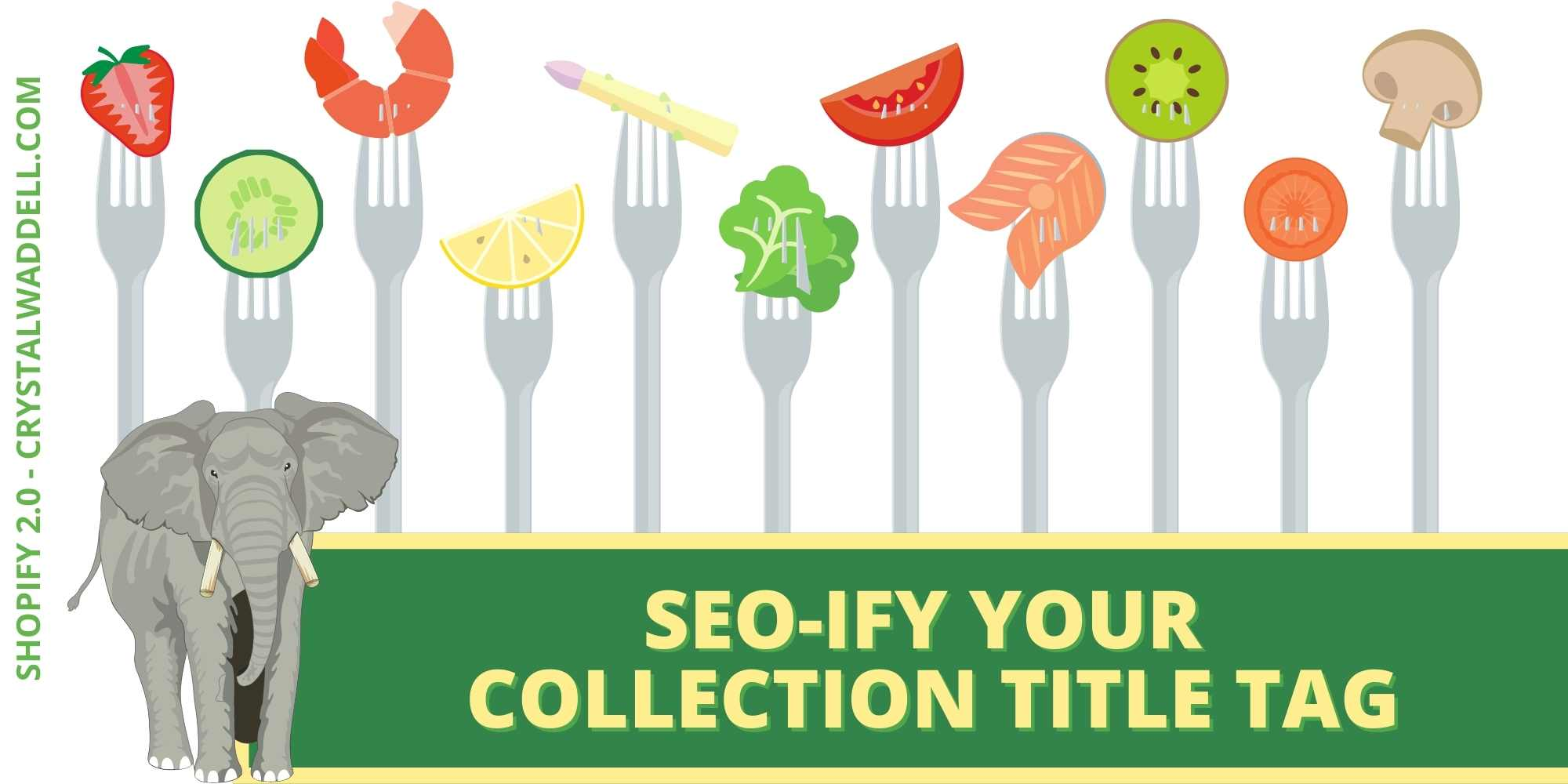
19. COLLECTION DESCRIPTION
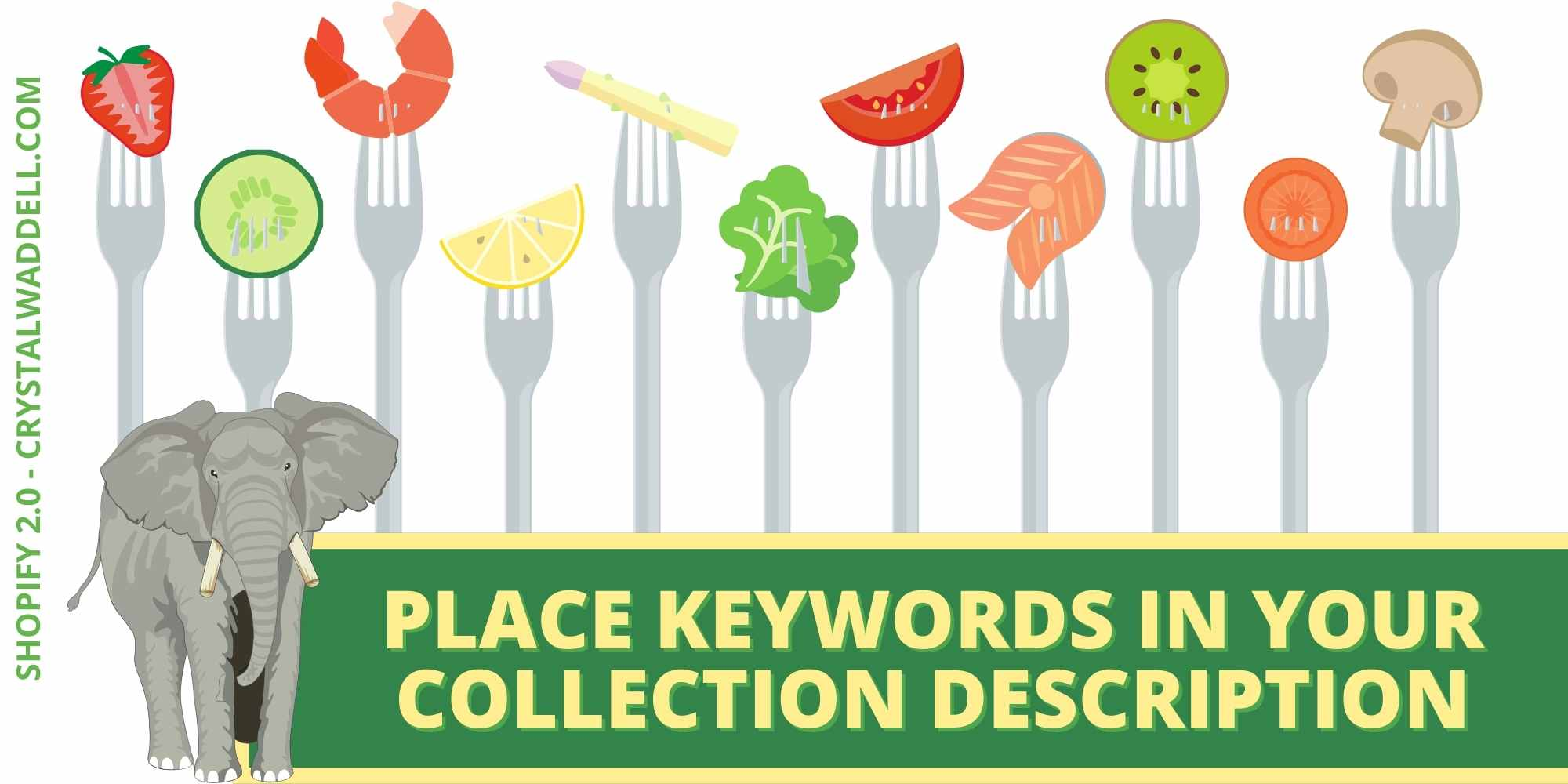
A well-written, keyword-rich collection description ranks higher in search engine results pages.
This a content marketing strategy GOLD for your Shopify website.
Many site owners ignore the content on their collection pages (or don't know about it!)
Including keywords that reflect the search intent for your page?
That will ensure potential customers view your collection page as a solution!
Any collection description is valuable real estate! Let's start from the top!
20. COLLECTION PAGE TITLE WITH KEYWORDS
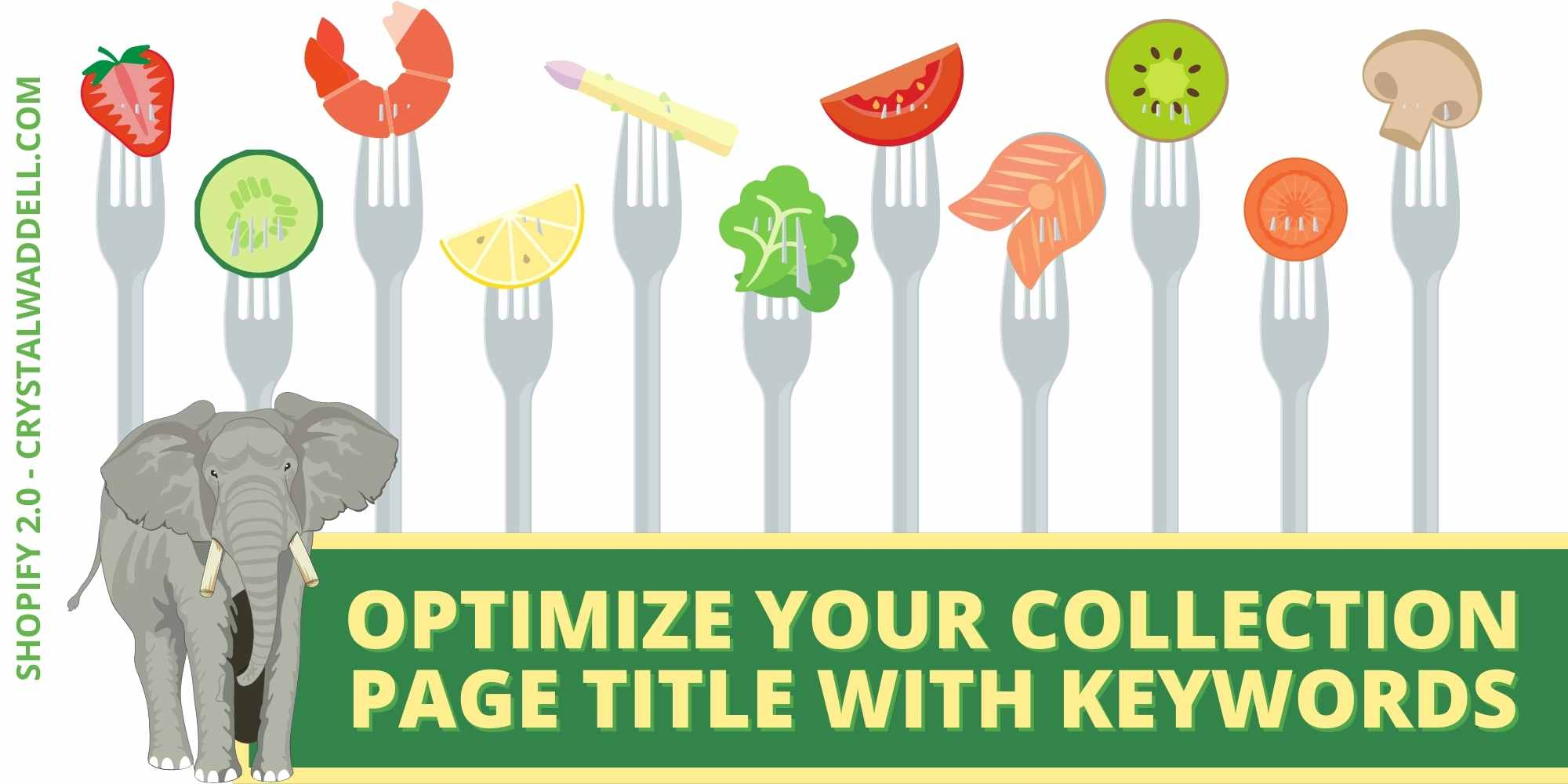
Keywords in collection page titles are important for two reasons:
- Keywords help optimize your page for search engines, so you can reach a larger audience.
- Relevant keywords help your collections get discovered. Use them to increase the chances that customers will visit your page and learn more about what you offer.
21. COLLECTION META DESCRIPTIONS WITH KEYWORDS
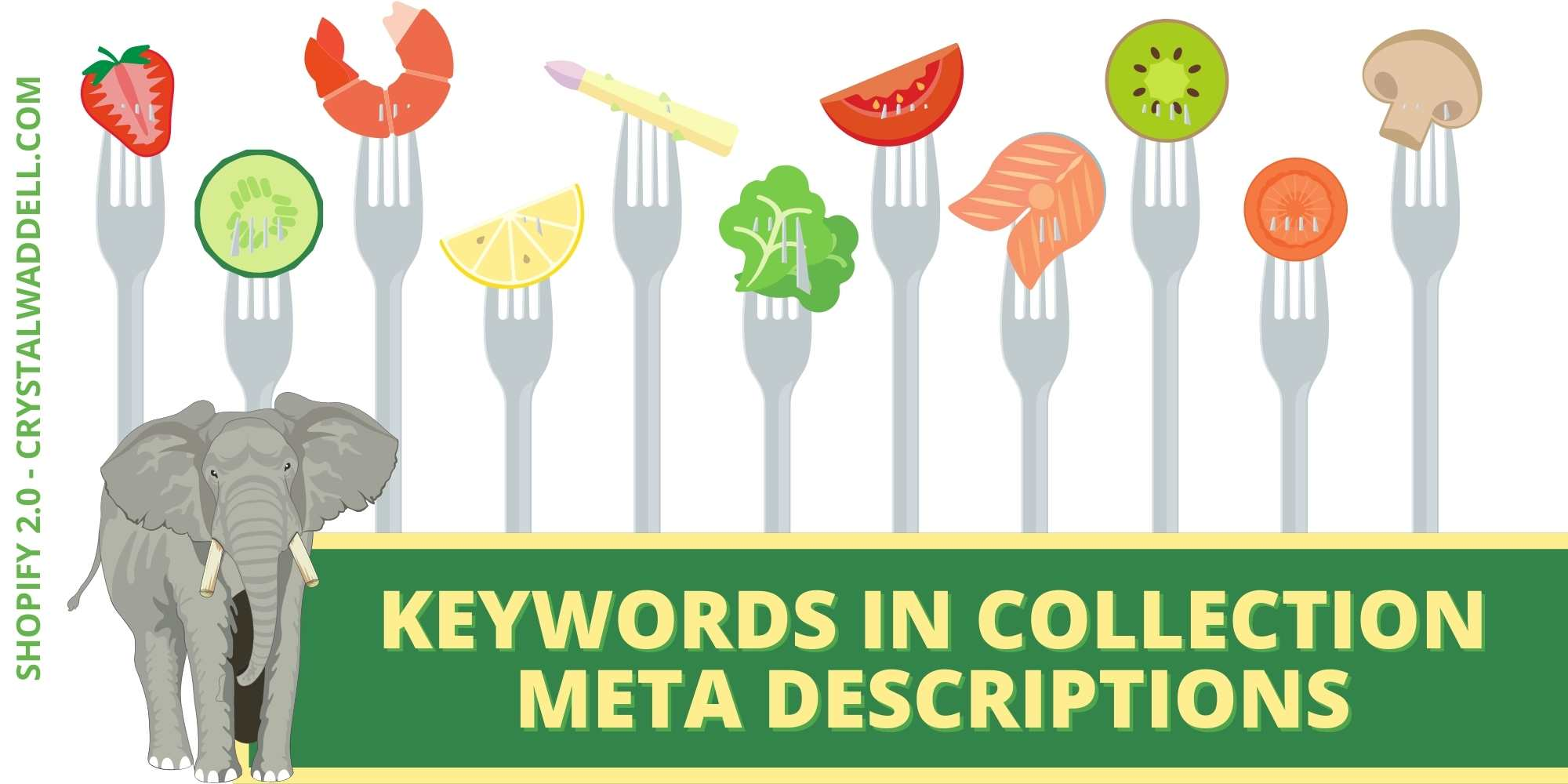
Place related keywords within your collection meta tags.
Again, another way to help your collections rank higher in search results.
Same story, different location!
Including keywords in your collection meta description helps search engines index your site.
To edit a collection's meta description: go to the Collections page in your Shopify admin.
Click on the name of the collection that you want to edit.
Then scroll to the bottom of the page and edit the SEO name and description.
22. COLLECTION PAGE URLS WITH KEYWORDS
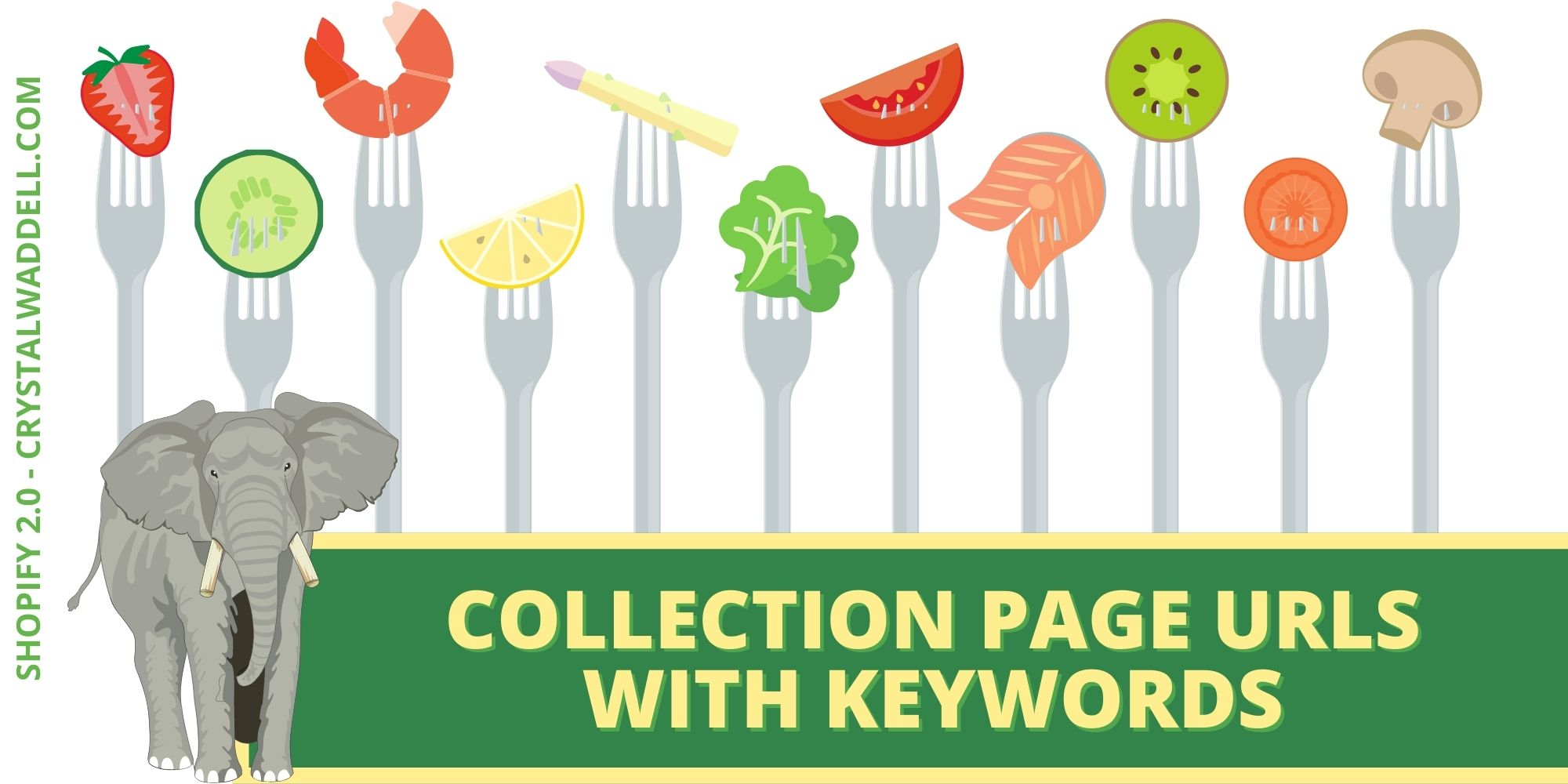
Technical SEO will help you optimize your website for search engines.
For instance, your "Collection URL slug."
This is the part of the URL that comes after your domain name, and it can be a great place to include some keywords.
For example, let's say you have a website about cars from different eras.
Your Collection URL slug might look like this: www.CrystalCars.com/vintage-cars
Here, "vintage cars" is your target keyword AND the title of your collection.
Ensure your site is using technical SEO and incorporating relevant keywords.
Together, they will help potential customers find your online business.
23. COLLECTIONS PAGE IMAGE - OPTIMIZED IMAGE FILE
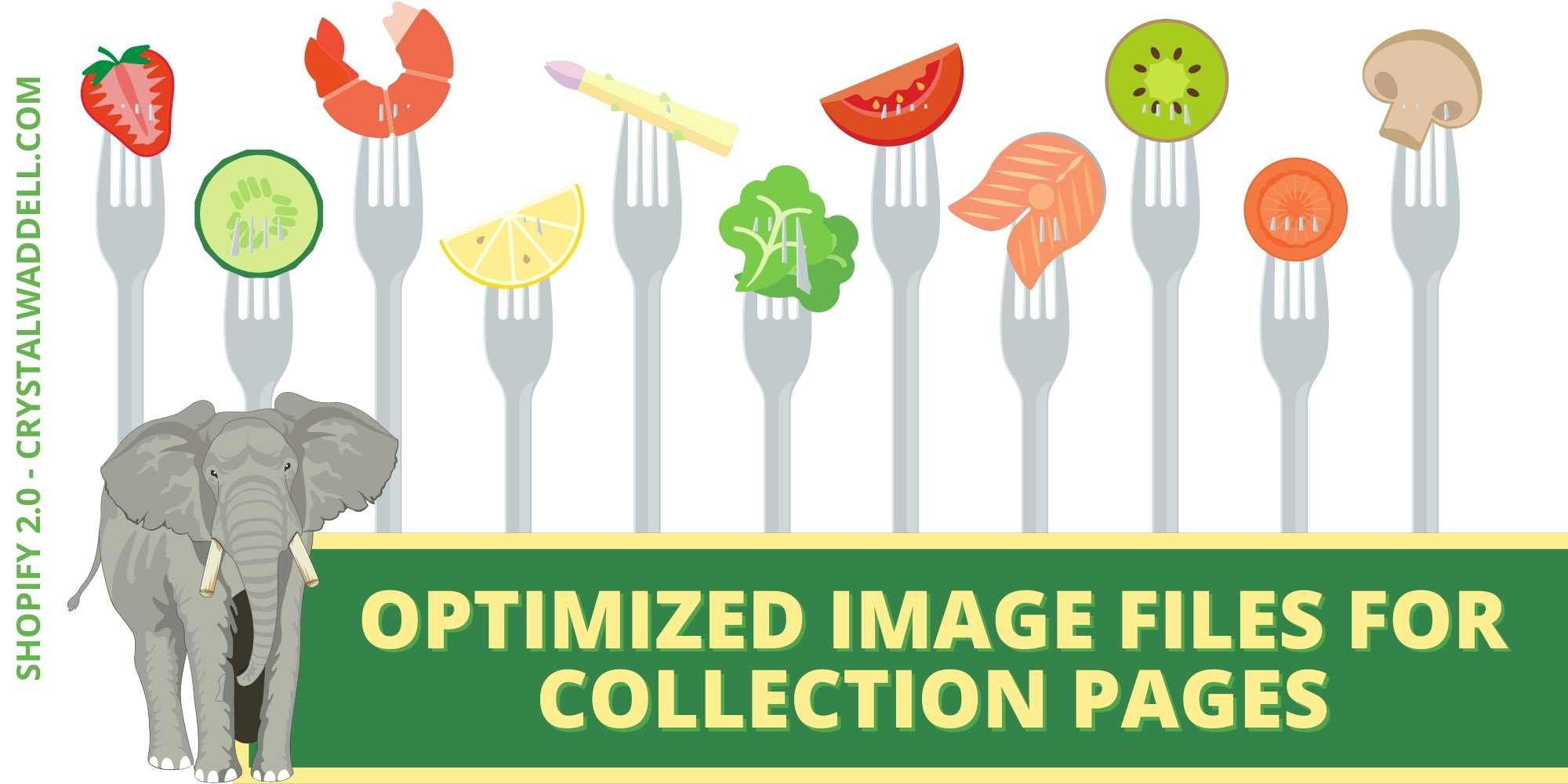
It's always important to ensure to optimize your images for the web.
This means creating image files that are the right size and resolution for your website.
Shopify themes help you do this but you can further optimize.
Check out two more ways to optimize your image files:
- Use an Image Editor on your phone or online. You can size and resize images on Canva.com as well.
- Resize Your Images: When dealing with images for the web, file size is important. This is because the larger the image, the longer it will take the file to load.
The longer it takes your file to load, the slower your site speed. So remember, fast-loading images equals faster site speed.
24. ADD INTERNAL LINKS
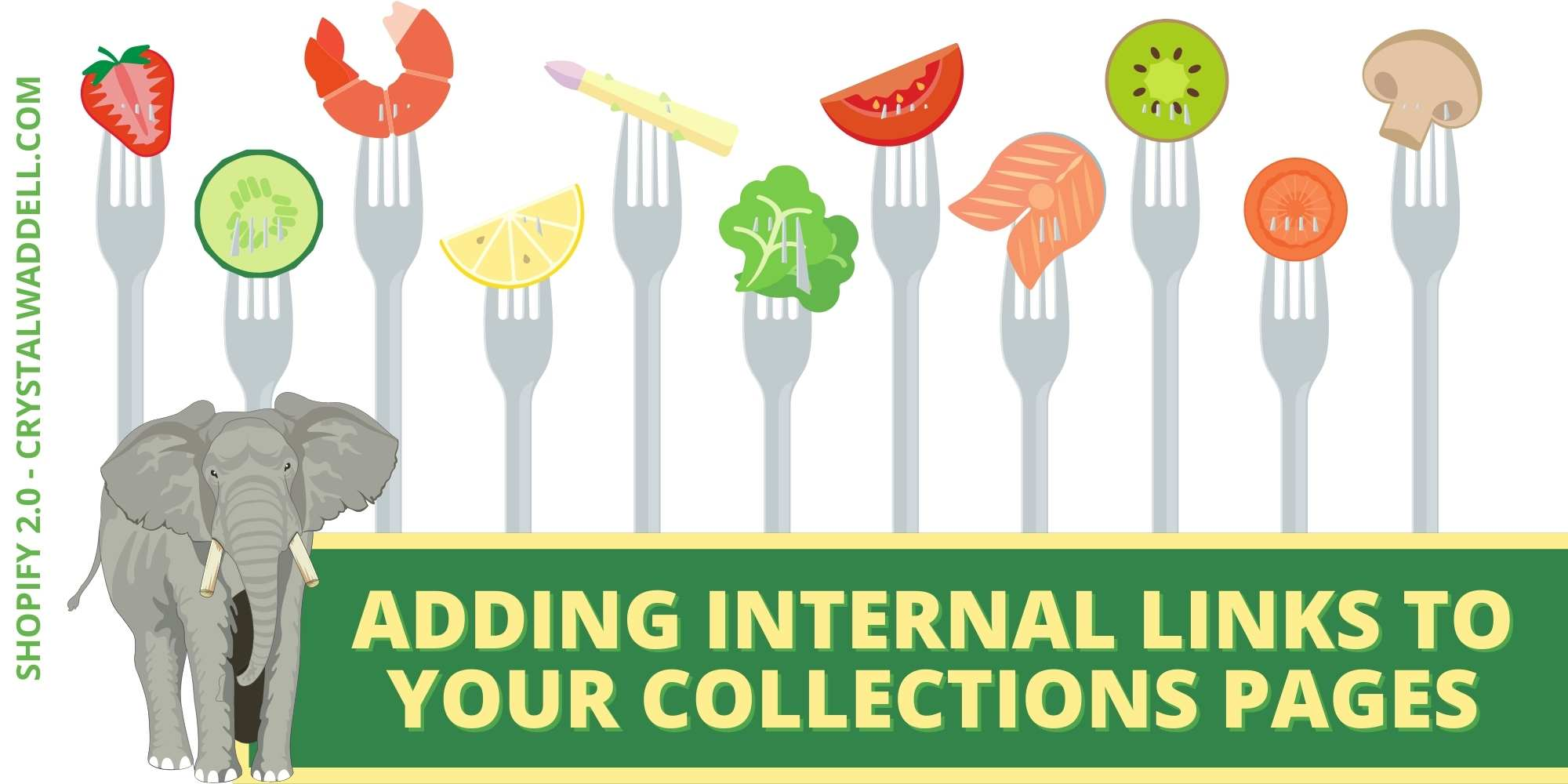
There is more than one reason to use internal link-building on your collection pages.
One reason is that it can help improve your Shopify site's SEO.
Another reason is that it can help keep people on your site longer, which can lead to increased sales.
One place you might want to consider adding internal links is within the "Description."
You could also add them through the images of your page's content. Think of it as creating directions for Google and human beings to explore your site.
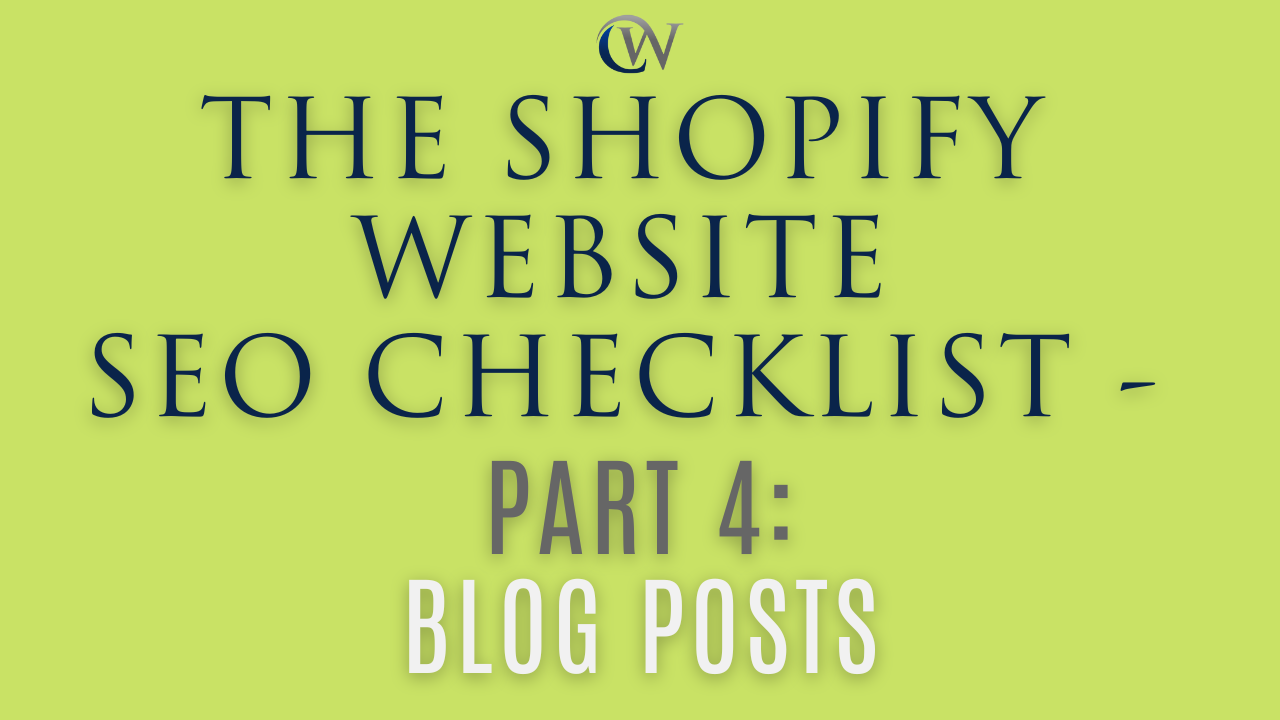
25. BLOG POST TITLES WITH KEYWORDS
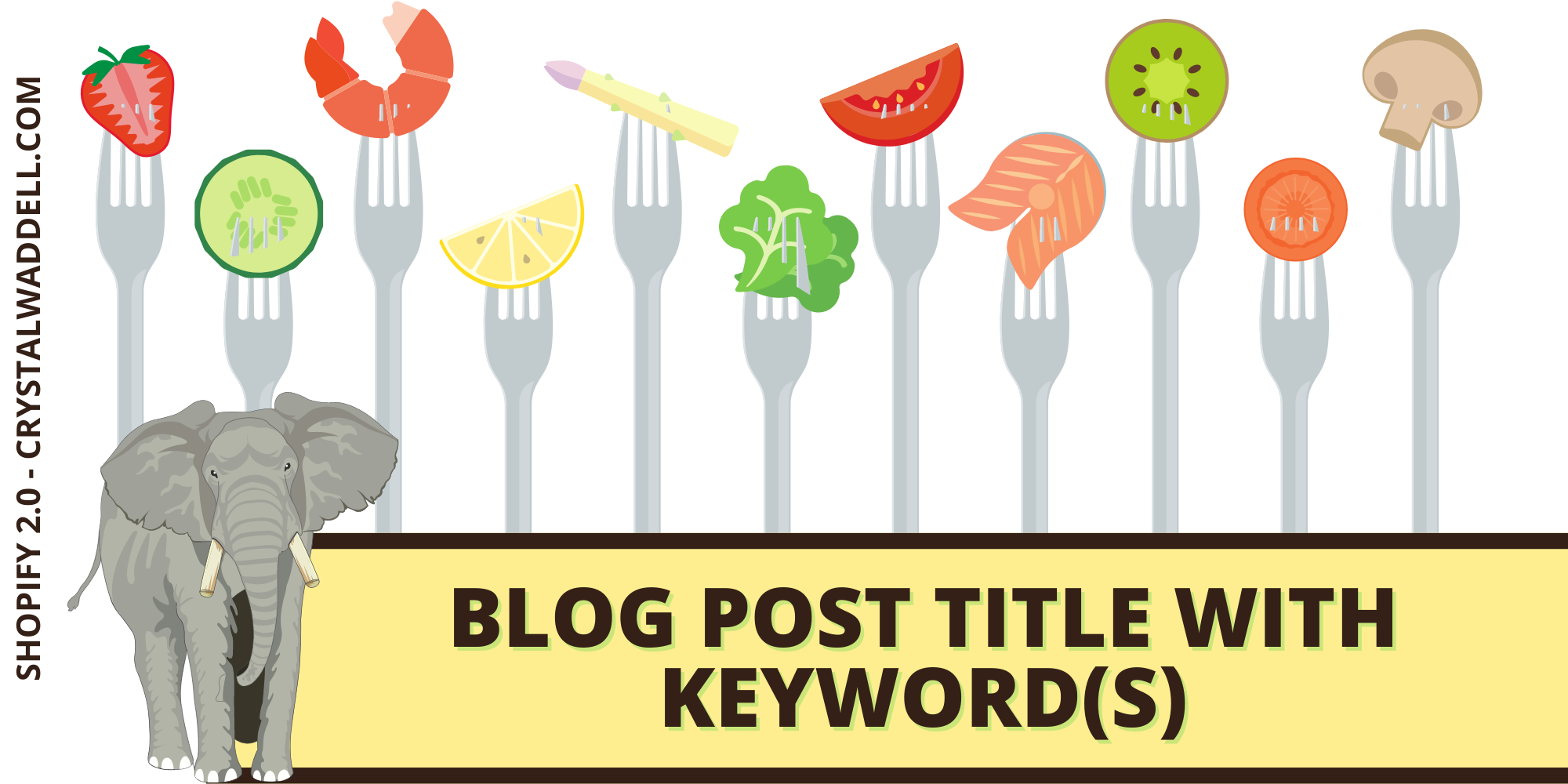
Have you noticed the pattern yet? Keywords go everywhere.
Including your target keywords in post titles will help your store rank as a trusted result.
Let's use wedding shoes as our example.
One method is to include the keyword as part of the post title itself.
Additionally, you want to put the keywords towards the front of the title.
Another pro tip: use brackets. I have read in several articles that adding brackets increases click through rates.
So in this example, a great way to integrate both of these techniques would result in this blog title:
Wedding Shoes For Your Big Day [Find The Perfect Pair]. Your title needs to fall within 50-59 characters. (Okay, a max of 60 works, too!)
You can always check your character count using the site wordcounter.net.
One last pro tip (I'll link to an article about this soon!):
Consider the Search volume and search intent for your keyword.
The keyword choice "wedding shoes" could be difficult to rank for.
The monthly search volume is 100K+ and search difficulty 80+.
But, if you choose a keyword like "wedding shoes block heel,"you have a better shot of ranking.
This long-tailed keyword still has a strong monthly search volume.
Monthly searches are 8100. The search difficulty is lower, at 60+.
So there is some strategy to unpack for this keyword. More resources to come!
26. BLOG CONTENT THAT INCLUDES KEYWORDS AND LINKS
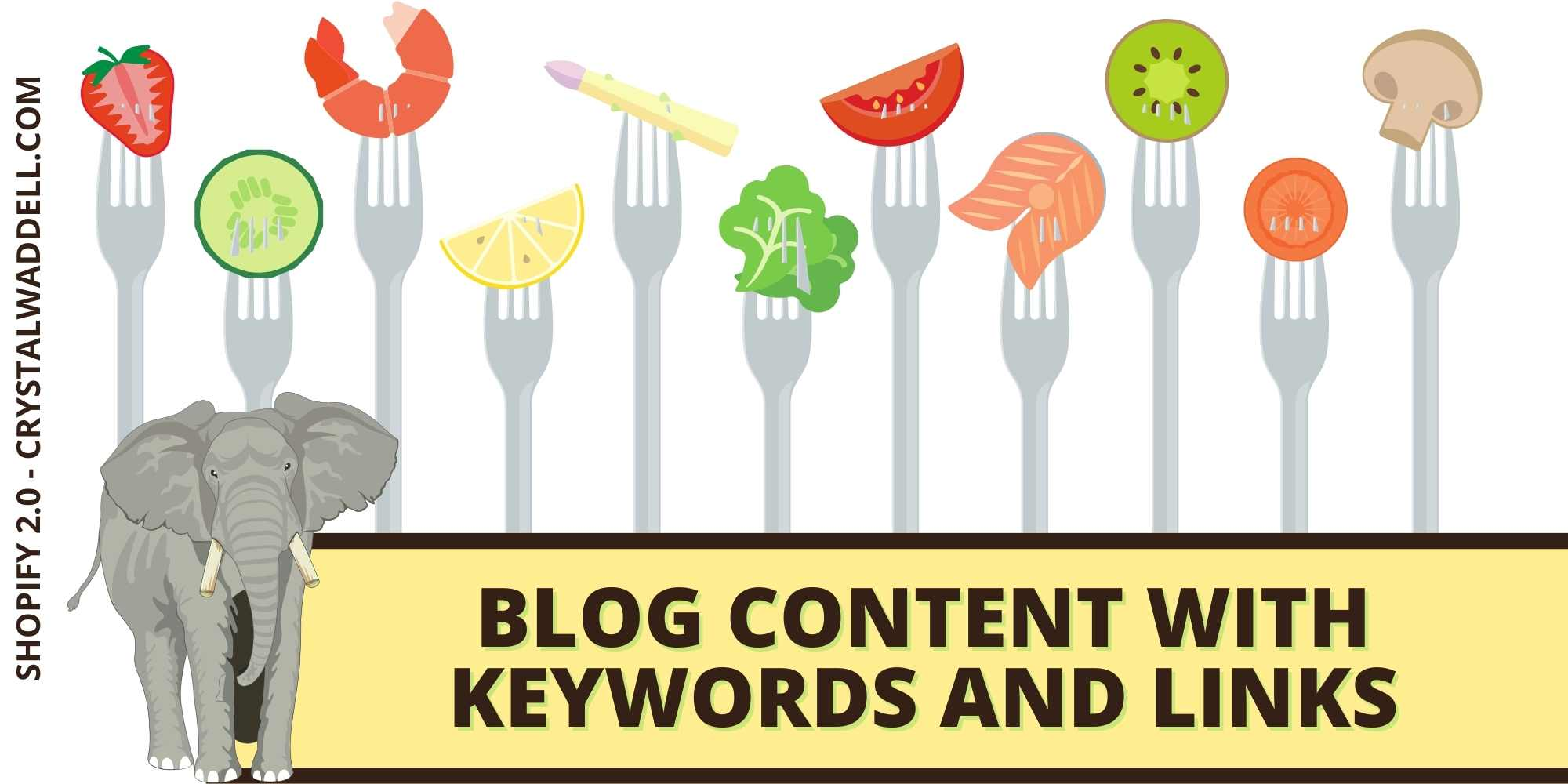
You can also improve your SEO by including internal links to other pages on your site from your blog.
For e-commerce sellers: this means writing articles about your products. Then link TO your products. Don't be shy!
When including keywords, be sure to use them in a way that sounds natural and doesn't sound forced.
Internal linking is a great way to help keep people on your site longer. Remember, internal links created by 3rd party apps may not remain if you delete the app.
28. BLOG EXCERPT WITH KEYWORDS
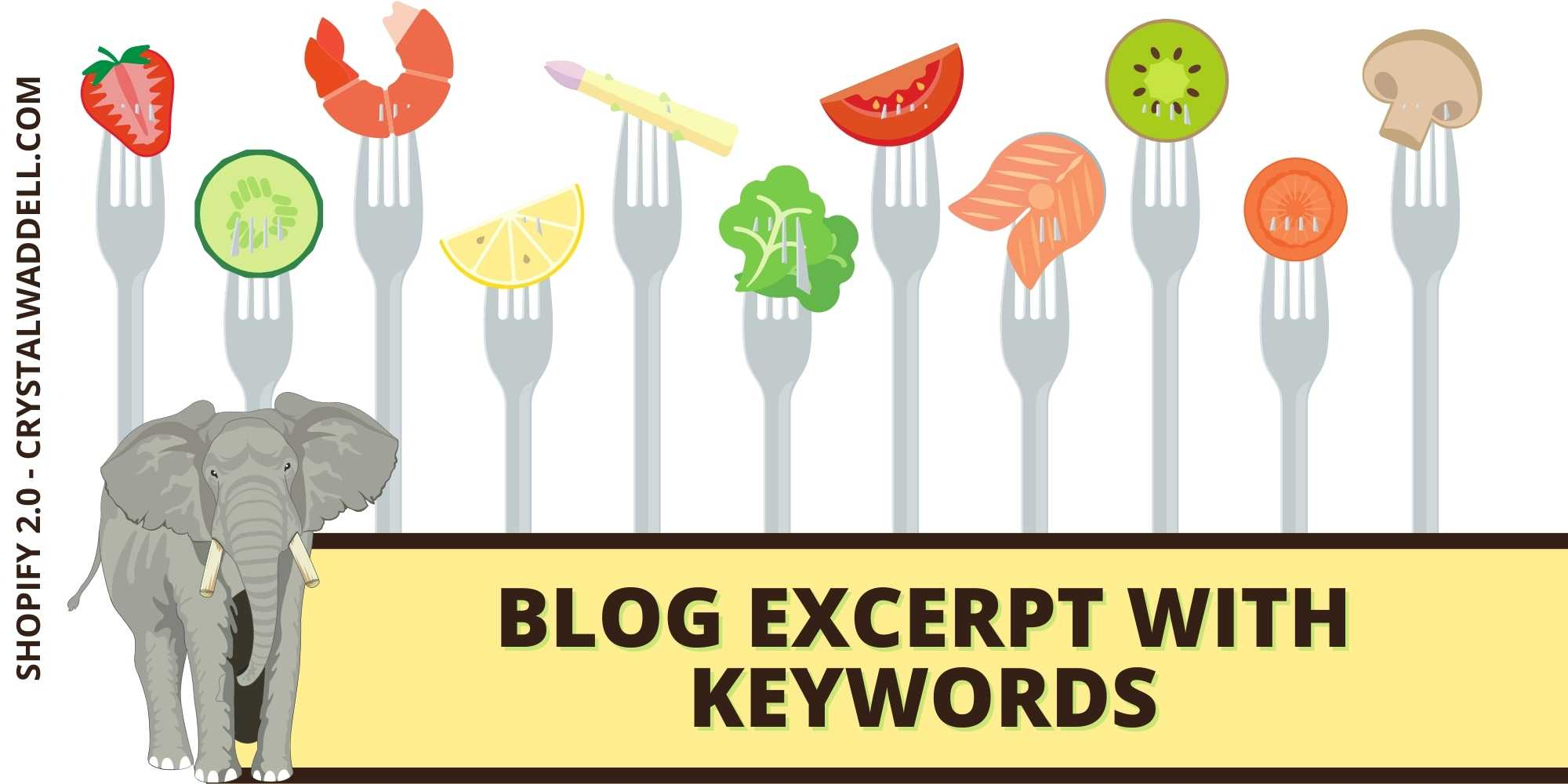
The blog excerpt is a great way to increase the visibility of your blog posts in search engines.
You can give your blog post more opportunities to show up when people search for those terms.
To use the blog excerpt space on Shopify, go to the 'Excerpt' section when editing a blog post.
Here, you can enter a brief summary of your post. Your blog will show your excerpt on your blog's homepage and in search results.
Be sure to include relevant keywords so that people can find your content!
28. BLOG TO BUILD AUTHORITY AROUND YOUR PRODUCT PAGES
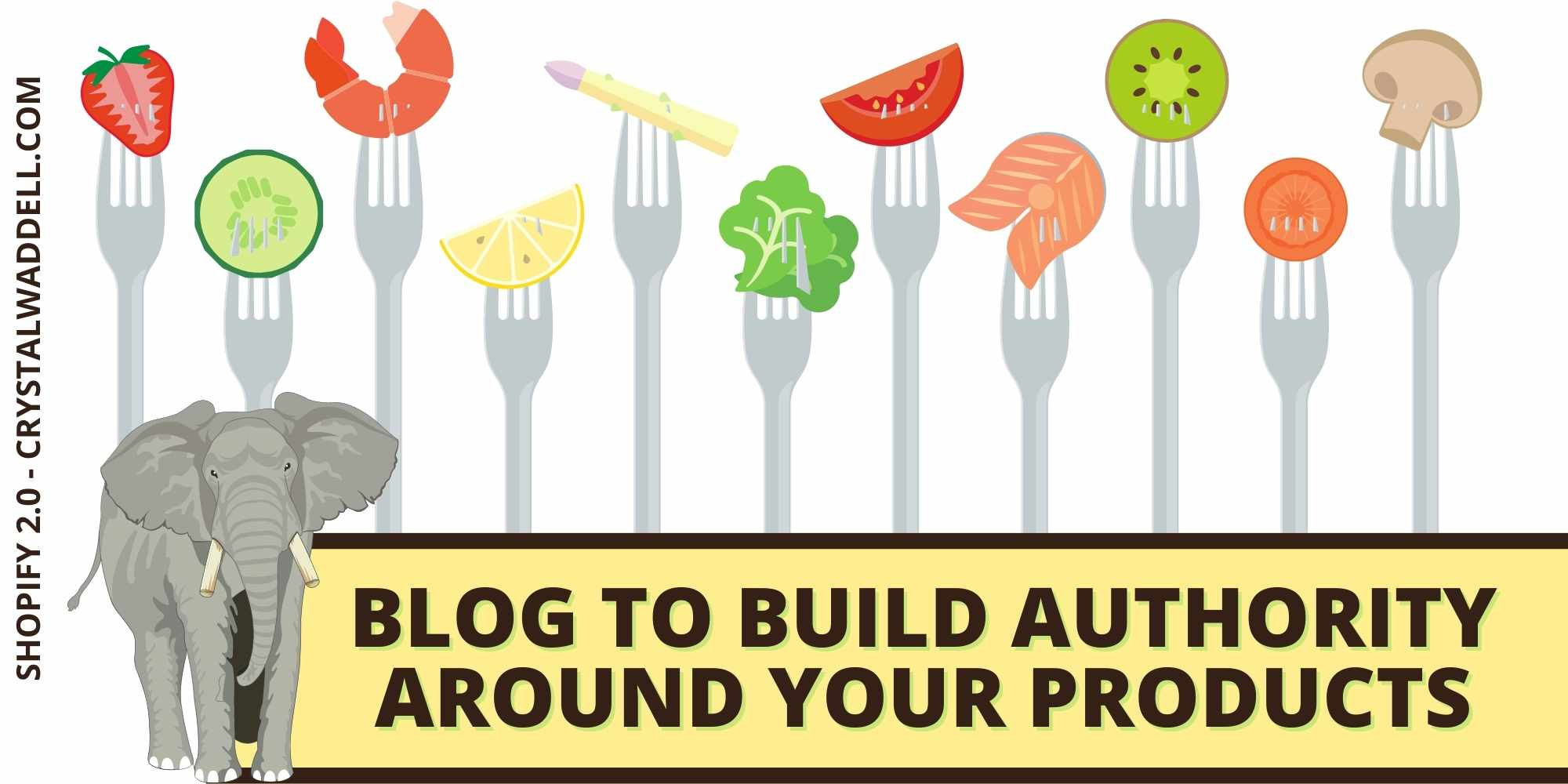
Again, the best way to establish authority on your Shopify site is to blog about the products you sell.
You'll not only help people learn more about your products.
You'll also increase your chances of ranking in Google for relevant content.
Additionally, make sure to link back to your product pages from your posts.
(And protip: avoid using demonstrative pronouns like "this" or "that". Avoid using "it". Instead of "it," use the specific keyword you want to target.)
30. BLOG IMAGES OPTIMIZED WITH KEYWORDS
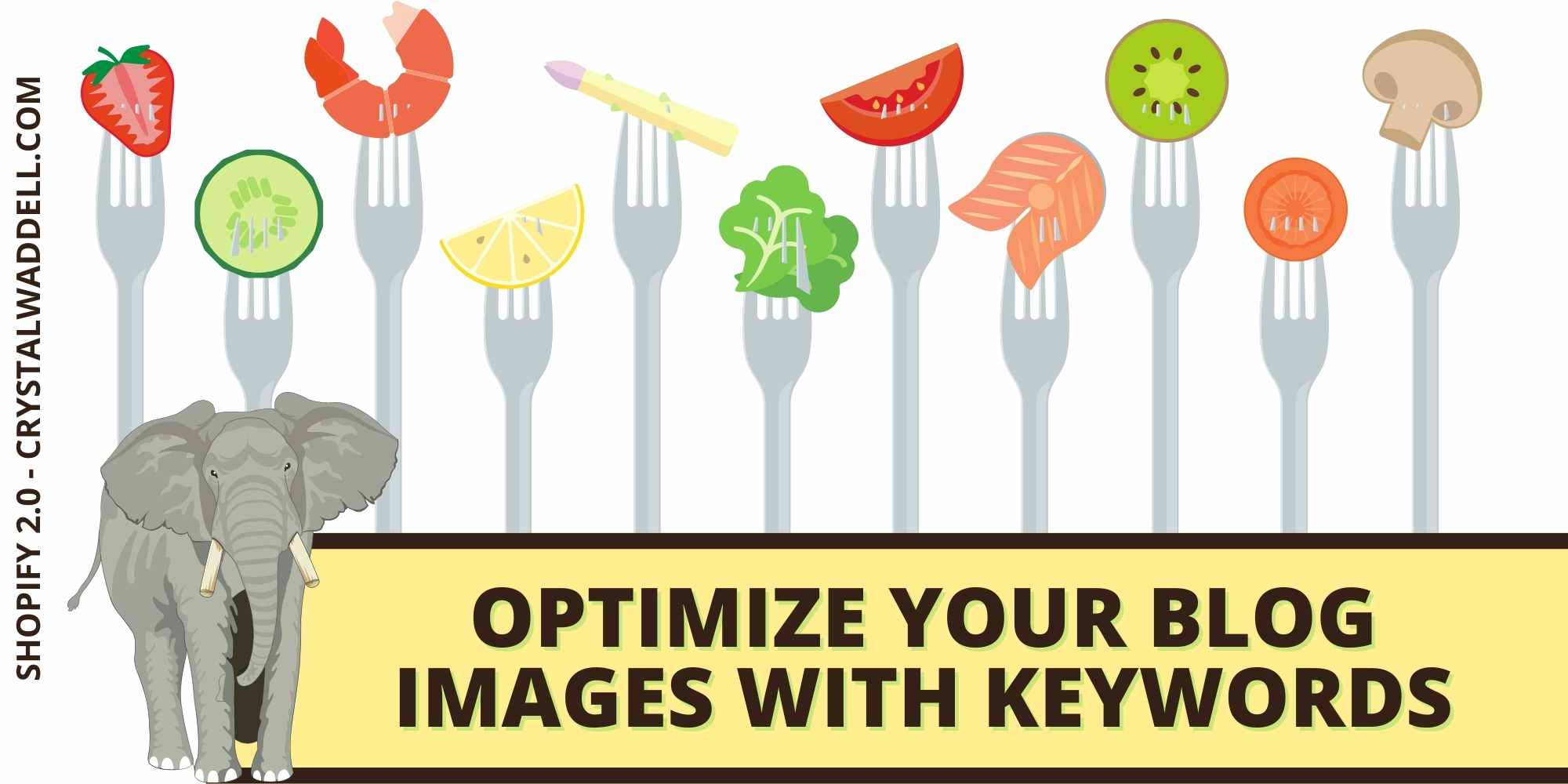
Technology has come a long way since the early days of the internet. Optimizing your blog images with keywords is now easier than ever.
Follow the tips shared in this article for optimizing your images. And for more creative SEO ideas, make sure to read this blog about utilizing public speaking as part of your SEO strategy!
The most important actions: include relevant keywords in the file name and alt text of each image.
30. BLOG PAGE TITLE WITH KEYWORDS
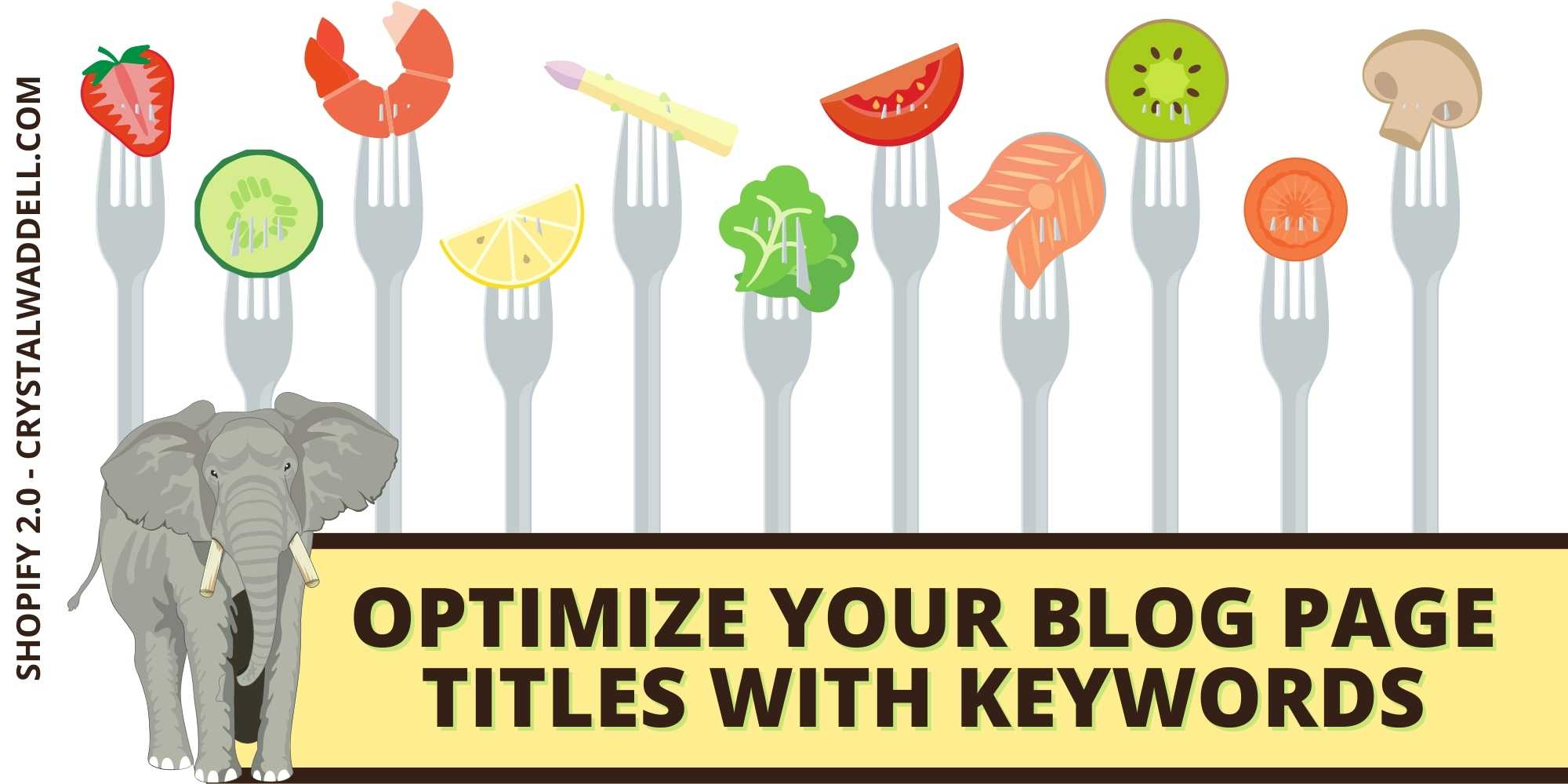
It's important to make sure that your keywords are relevant to the topic of your blog post.
You don't want to confuse readers or (gasp!) make them click away.
Once you've identified your target keyword, place it at the beginning of the title.
Also, you'll want to ensure to place your keywords in a natural way within the title - don't force them in if they don't fit.
31. BLOG META (TAG) DESCRIPTIONS WITH KEYWORDS
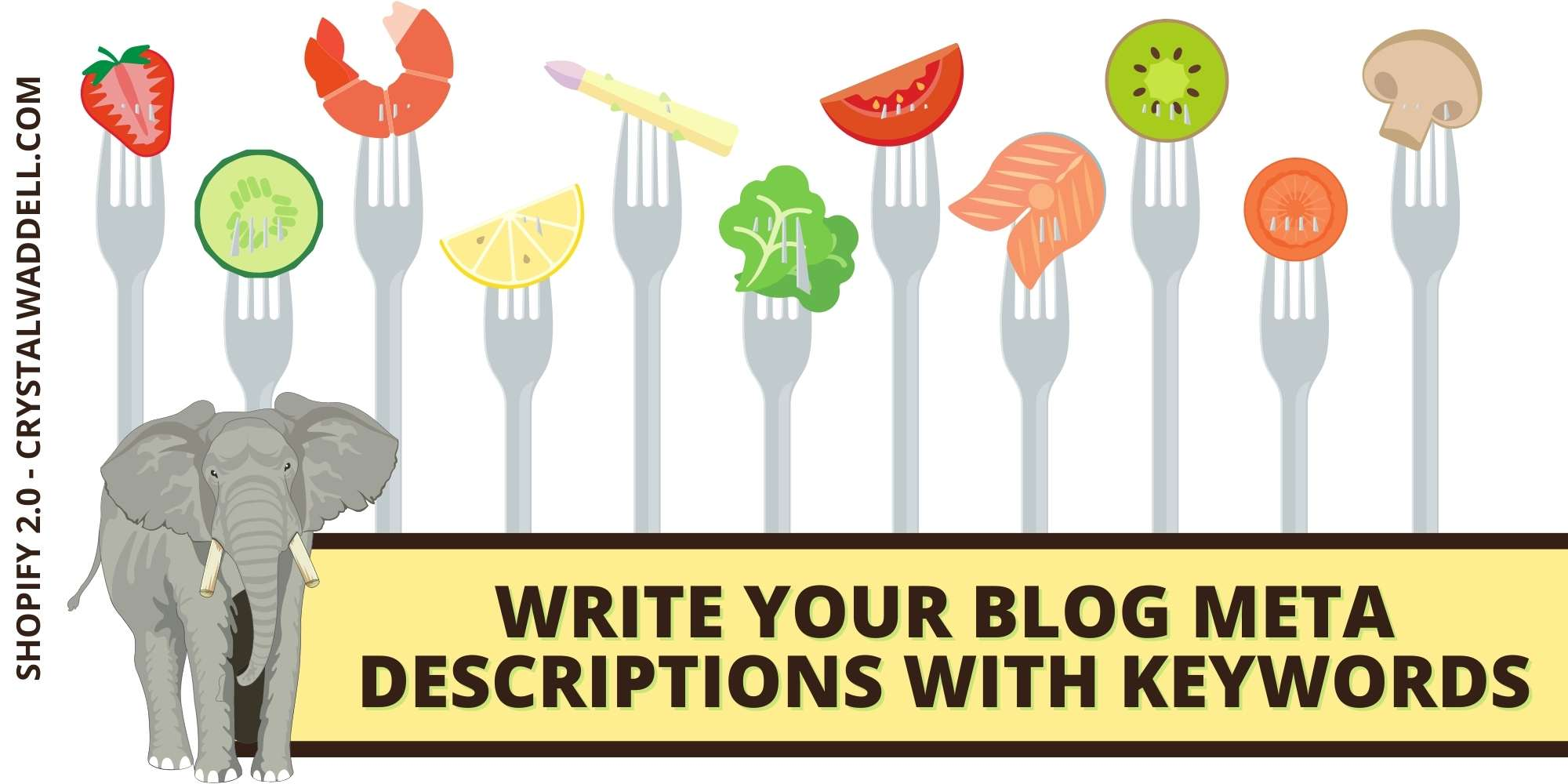
You should use your target keywords in your blog meta tags for the best results.
Your description will appear in the search results pages. The description equals another opportunity to encourage them to click through to your blog.
Including your target SEO keywords in your meta tags is one of the many ways you can improve your SEO.
32. BLOG URL WITH KEYWORDS
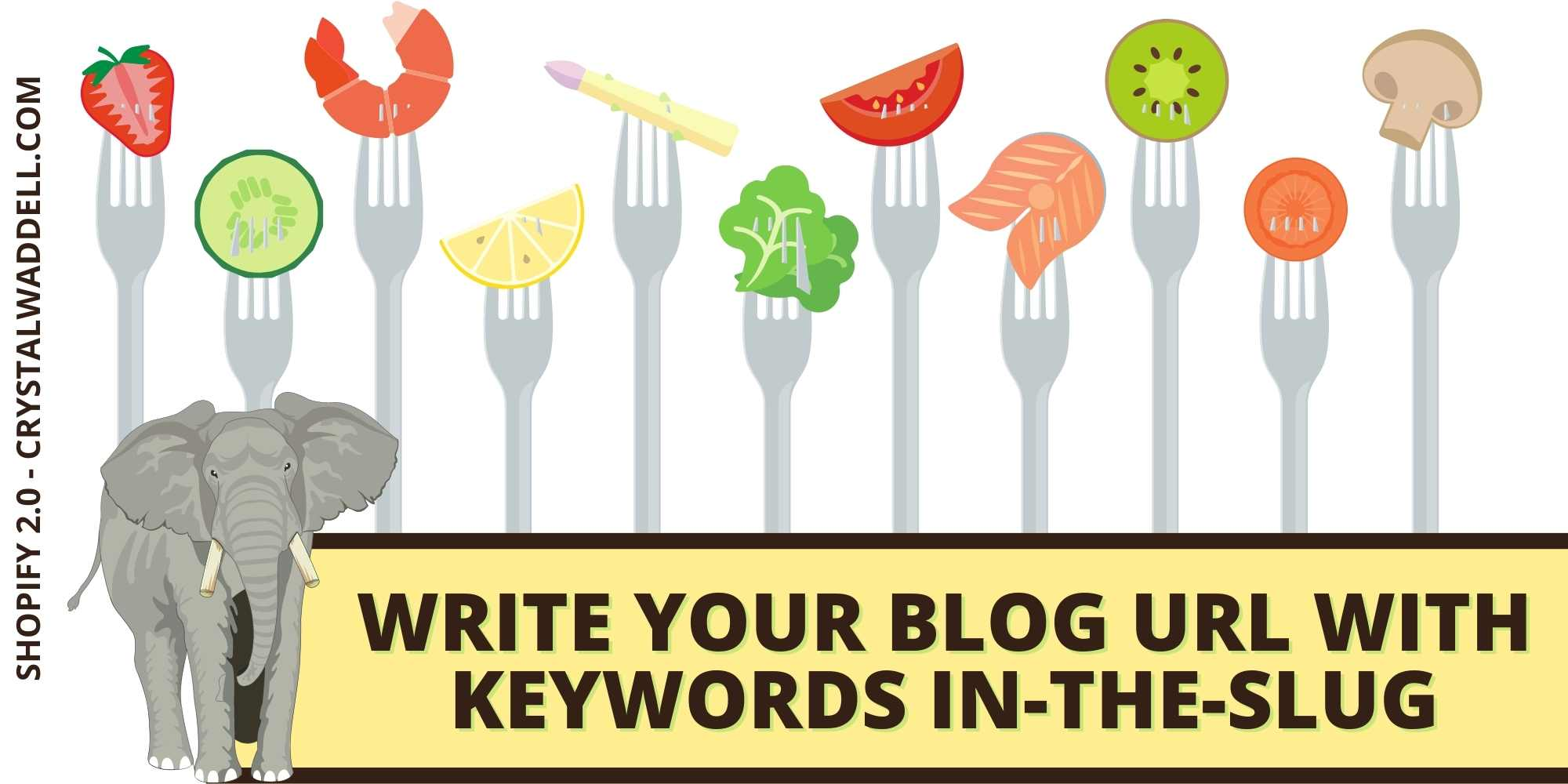
It's a good idea to include related keywords in your blog URL slug.
This is the part of the URL that comes after the domain name and "forward slash". Doing so will improve your website's visibility and organic traffic.
Here's an example if you're writing a blog article about healthy eating habits. Include "healthy-eating" in your URL slug:
https://www.mygreatwebsite.com/blogs/healthy-eating
Search engines and humans will understand at a glance what your post is about. Understood equals more likely to get clicked!
33. INTERNAL-LINK BUILDING OPPORTUNITIES
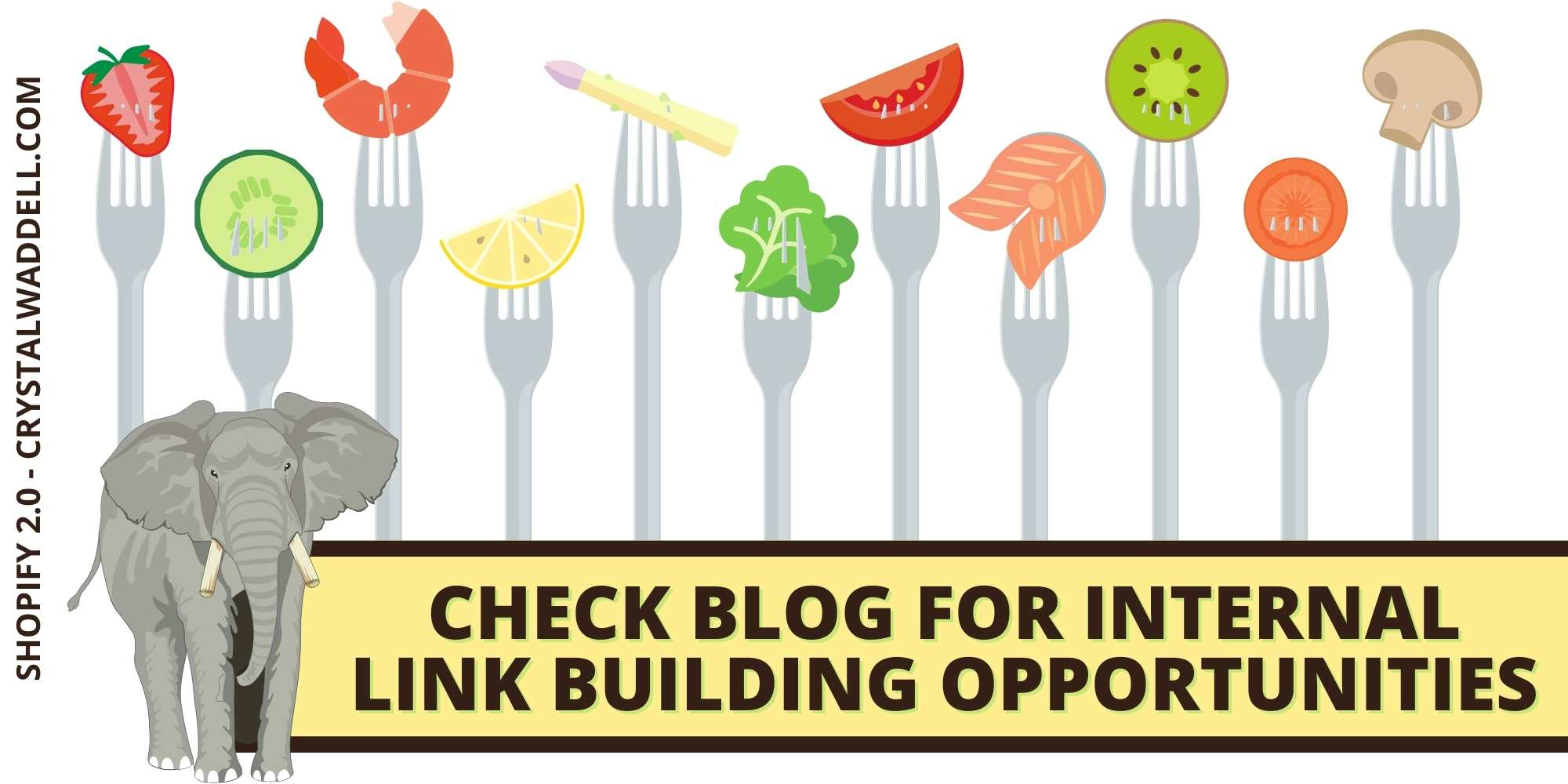
There are a few ways to double check for internal link building opportunities in your blog.
The most straightforward strategy that I use: linking to products within my Shopify.
When my products solve a problem for the reader of my blog, I have no problem with self-promotion!
Another option is to link to another blog or related content.
The link should include keywords that describe the linked content. This is also called "anchor text."
35. WILL YOU HAVE MORE THAN ONE BLOG?
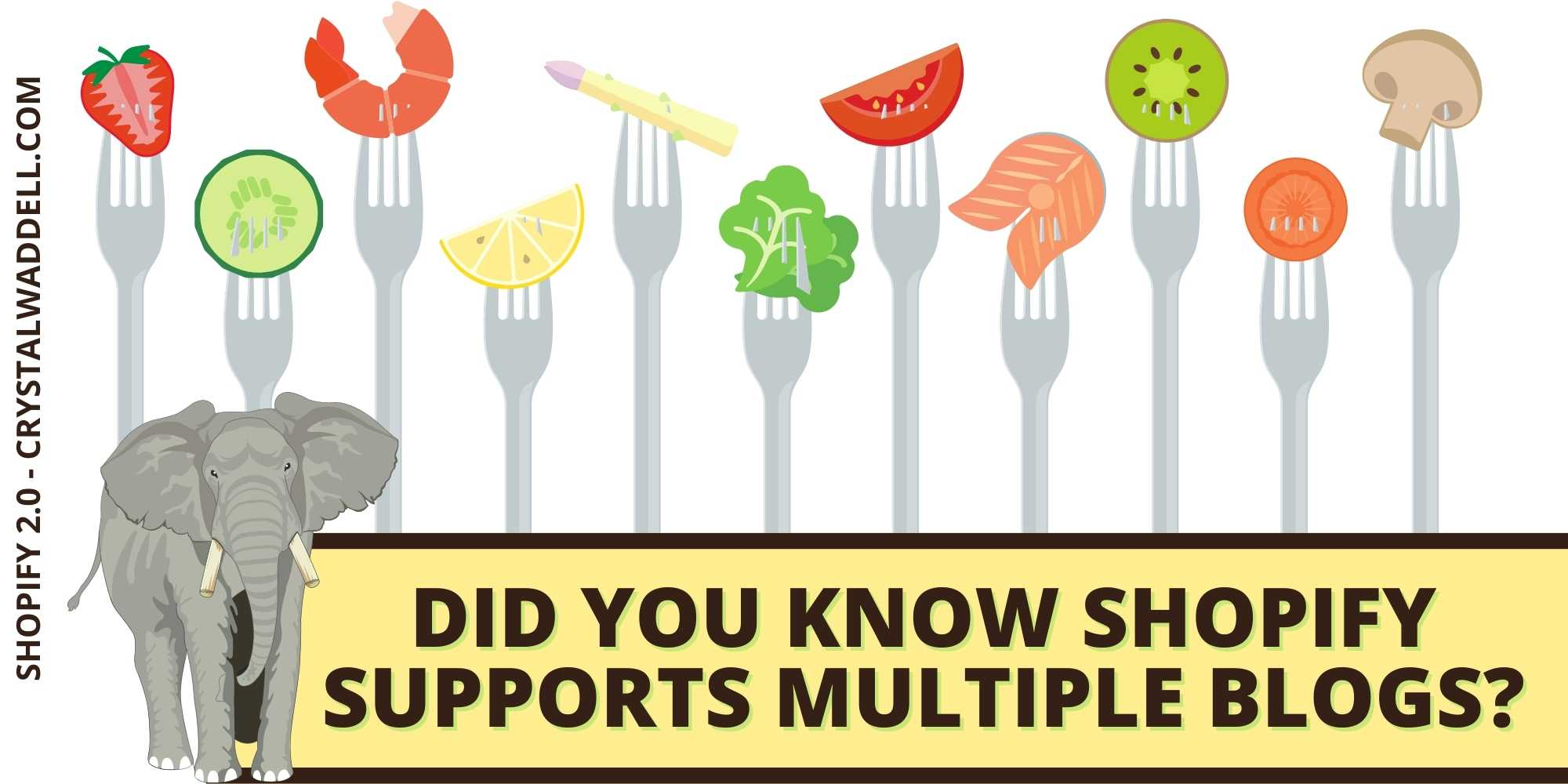
Didn't know you can have many blogs on your Shopify website?
Yes, you can have more than one blog on Shopify!
There are a few benefits of using many blogs:
First, you can target different audiences with each blog. On my Shopify website, I use a separate blog for different collections pages.
That way, it makes it easier to link from the blog to specific products or category pages.
I can make name signs for nursery decor and I make giant photo props for high school seniors.
Two completely different audiences need two completely different blogs!
Next, you can create more content for your shop's website. This will help you rank higher in search engines, and it will also help keep your customers engaged.
Content that promotes your products also eliminates the middleman content creator.
Content that attracts website visitors also means first-party data.
Every blog visitor you convert means extra dollars to your bottom line!
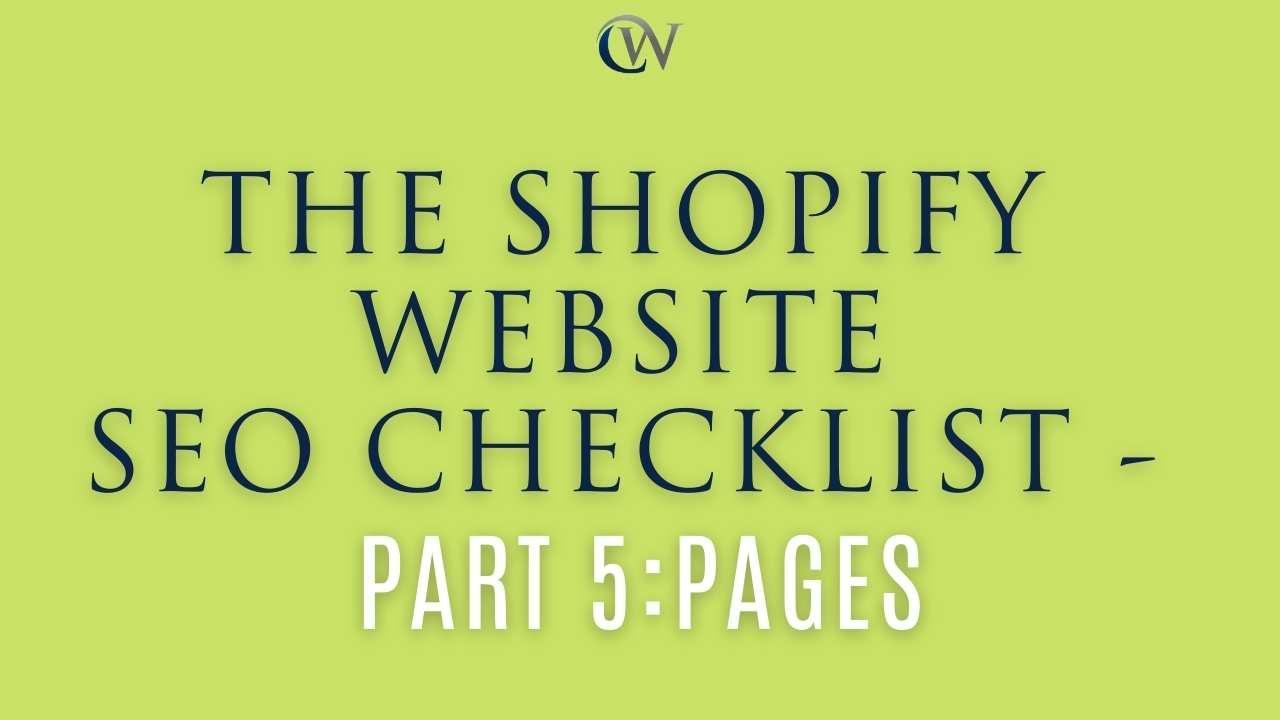
36. OPTIMIZING PAGE TITLE(S) WITH KEYWORD(S)
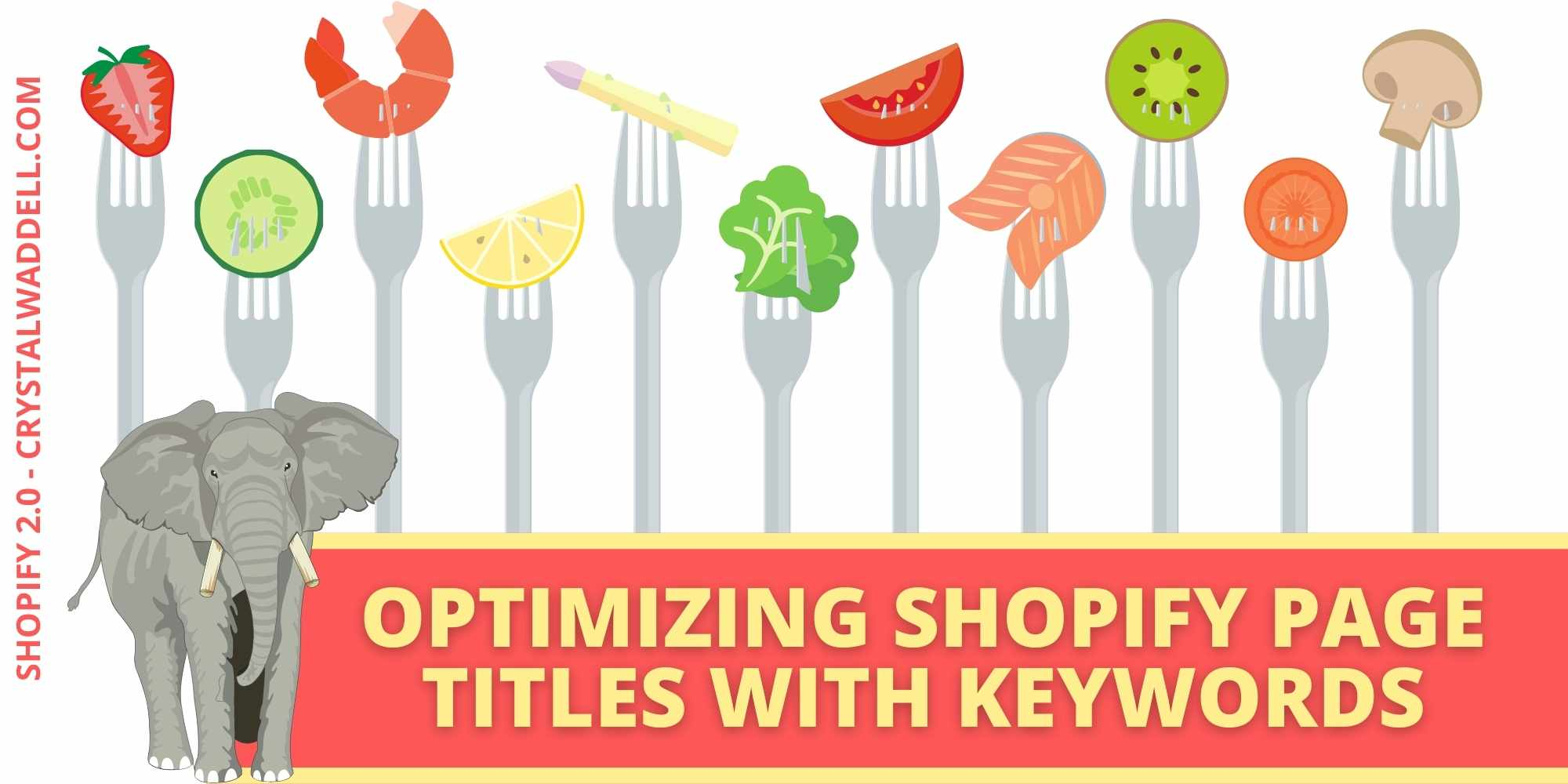
Page title is one of the most important on-page SEO factors.
To optimize your Shopify page titles for Google, you need to include your target keyword in the title.
Make sure that it reflects the content of your page.
Avoid your page title getting truncated in search results. Keep the title between 50 and 60 characters.
You can also add modifiers like "best", "top", "reviews", etc. to help improve your click-through rate (CTR).
36. OPTIMIZING PAGE CONTENT WITH KEYWORDS

Shopify pages are a great way to promote your business online.
I use pages to feature my company specific content. Content that is evergreen and relevant to future and current customers.
This content is different from blog posts.
For instance, what you're reading is company specific content.
I created this page to help my best customers, Shopify store owners like yourself.
To further optimize your page content for SEO, be sure to include your main keywords in:
- titles,
- descriptions,
- and throughout the body of your text.
You can also use specific tags to help boost your ranking.
Update your pages often with fresh and relevant information.
This will keep visitors interested and coming back for more. In the process, boosting your page ranking.
37. OPTIMIZE SEO TITLES WITH KEYWORDS
The best way to optimize your Shopify page SEO title will depend on your business and industry.
Here are a few tips to help you get started:
- Make sure your title is concise and descriptive.
- Include your target keyword(s) in the title, but don't overdo it.
- What would potential customers search for to find your product or service?
- Keep your title relevant to what's on the page.
- Test different variations and see what works best for you.
38. PAGE META DESCRIPTIONS WITH KEYWORDS
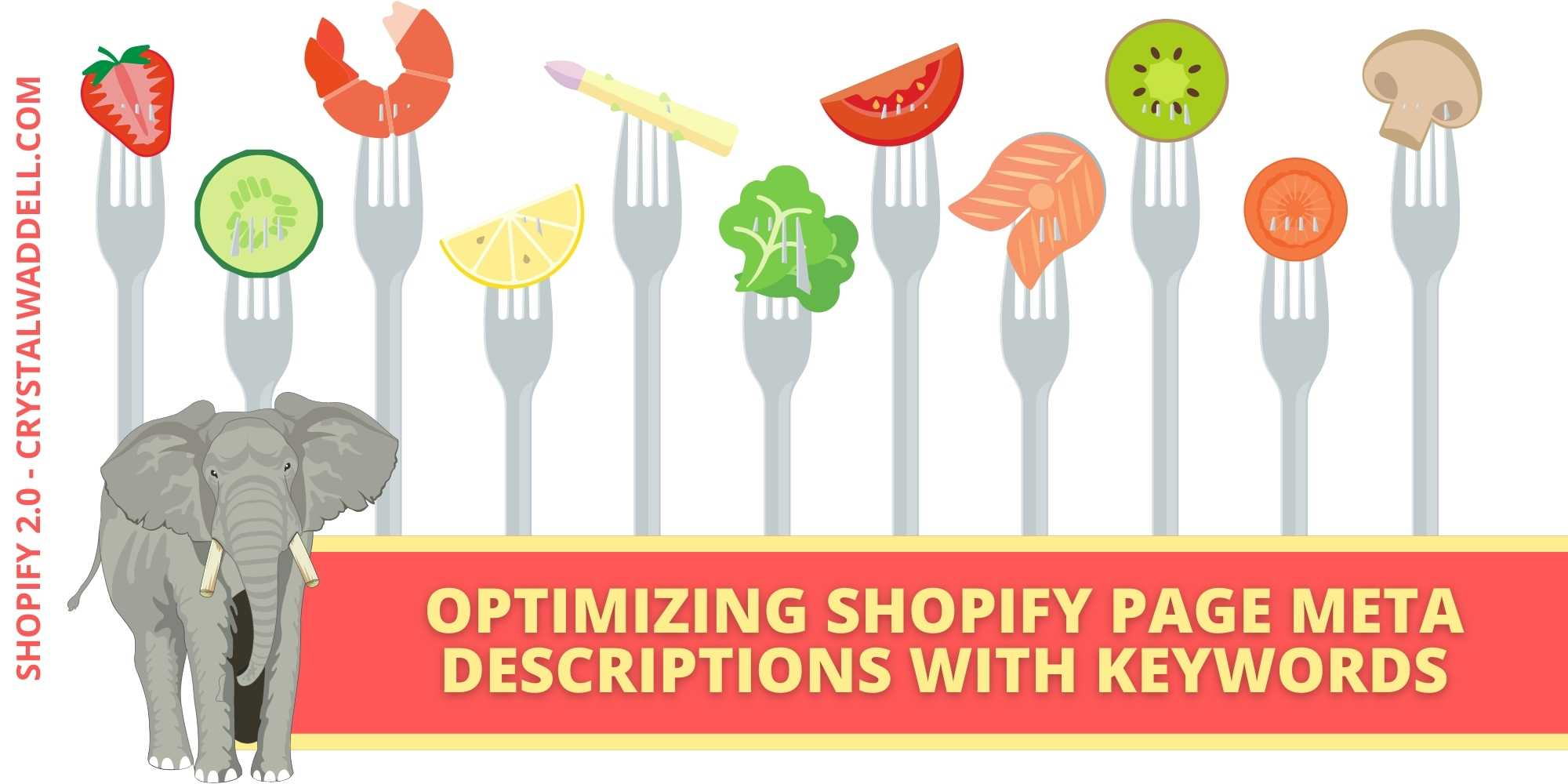
It's a good idea to keep your meta descriptions short and to the point.
You want users to scan them and know what they're going to find on your page.
The ideal meta description for your store's pages is 150-155 characters.
Optimizing your Shopify page meta descriptions mirror best practices for collections and products: unique and relevant.
Include relevant keywords that your optimal customers will likely search.
The best practice is always to lead with the value of your solution.
40. PAGE URLS WITH KEYWORDS
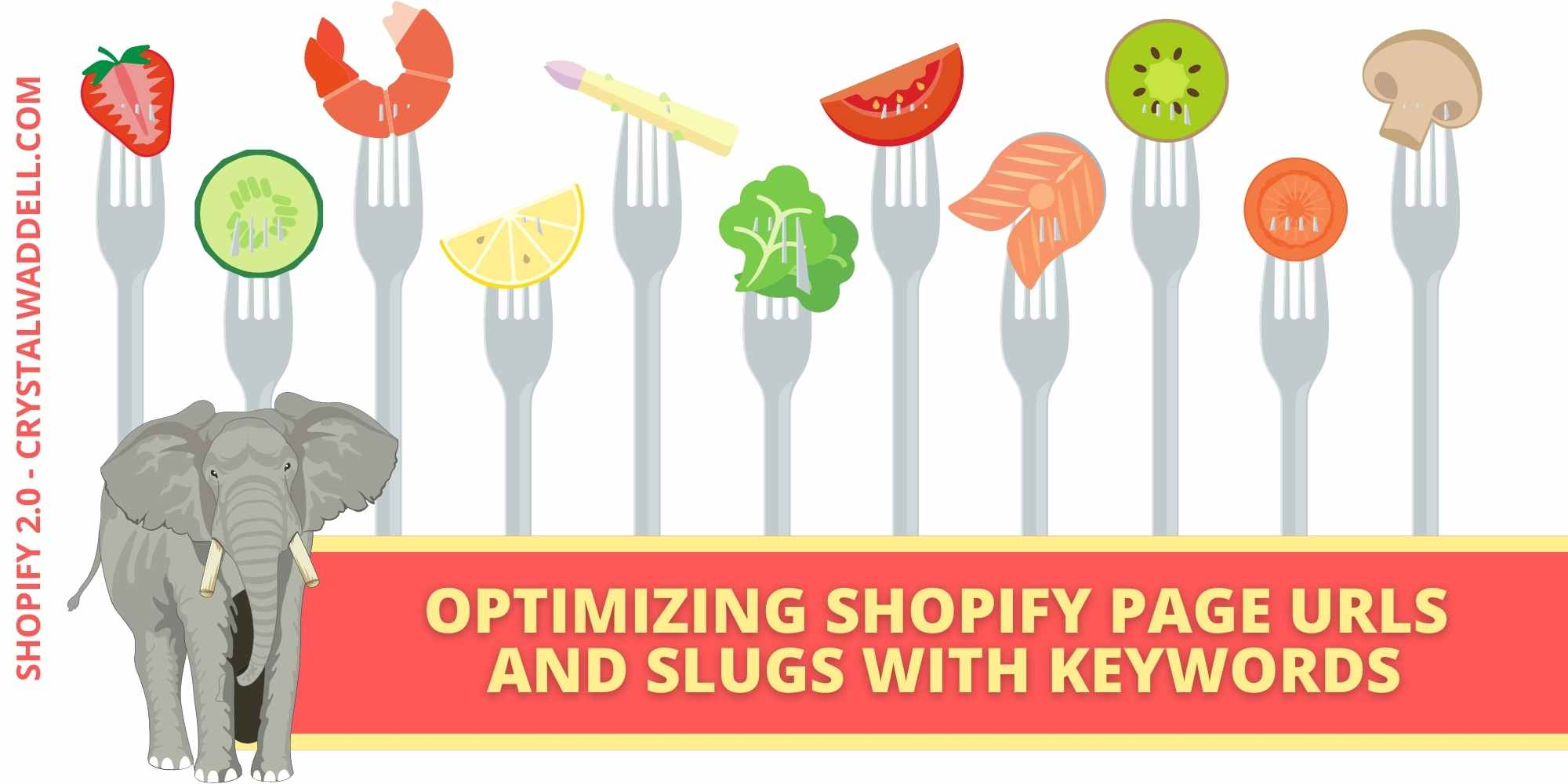
You can optimize Shopify "pages" URLs.
Use keywords to help your site rank higher in search engine results pages (SERPs).
When creating a page on your Shopify site, you'll want to use a keyword-rich title. Include it in the permalink (the web address of that page that also includes the "slug").
For example, if you have a page about mountain bikes, you could use a URL such as:
"https://www.shopify.com/pages/mountain-bikes".
This would help your Shopify site rank higher for the keyword "mountain bikes."
To sum it up, help your site rank higher in search engine results pages. Use the URL slugs to optimize your Shopify store URLs with keywords.
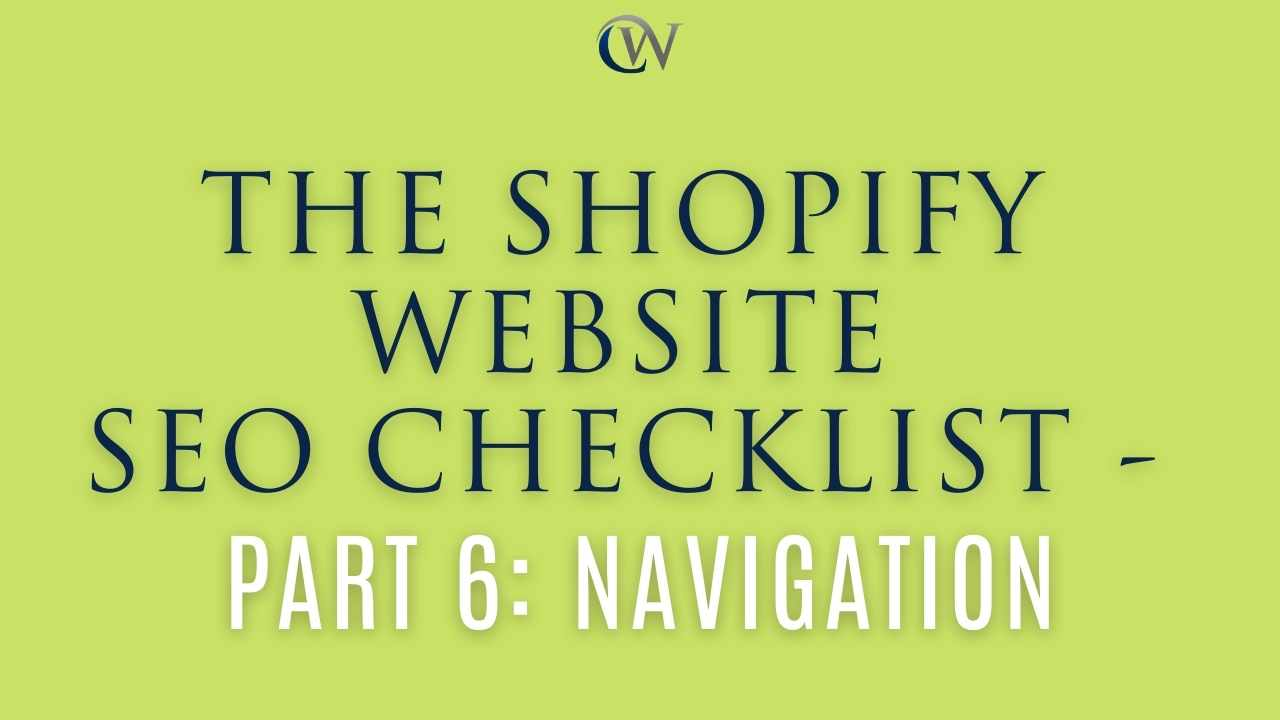
40. URL REDIRECTS
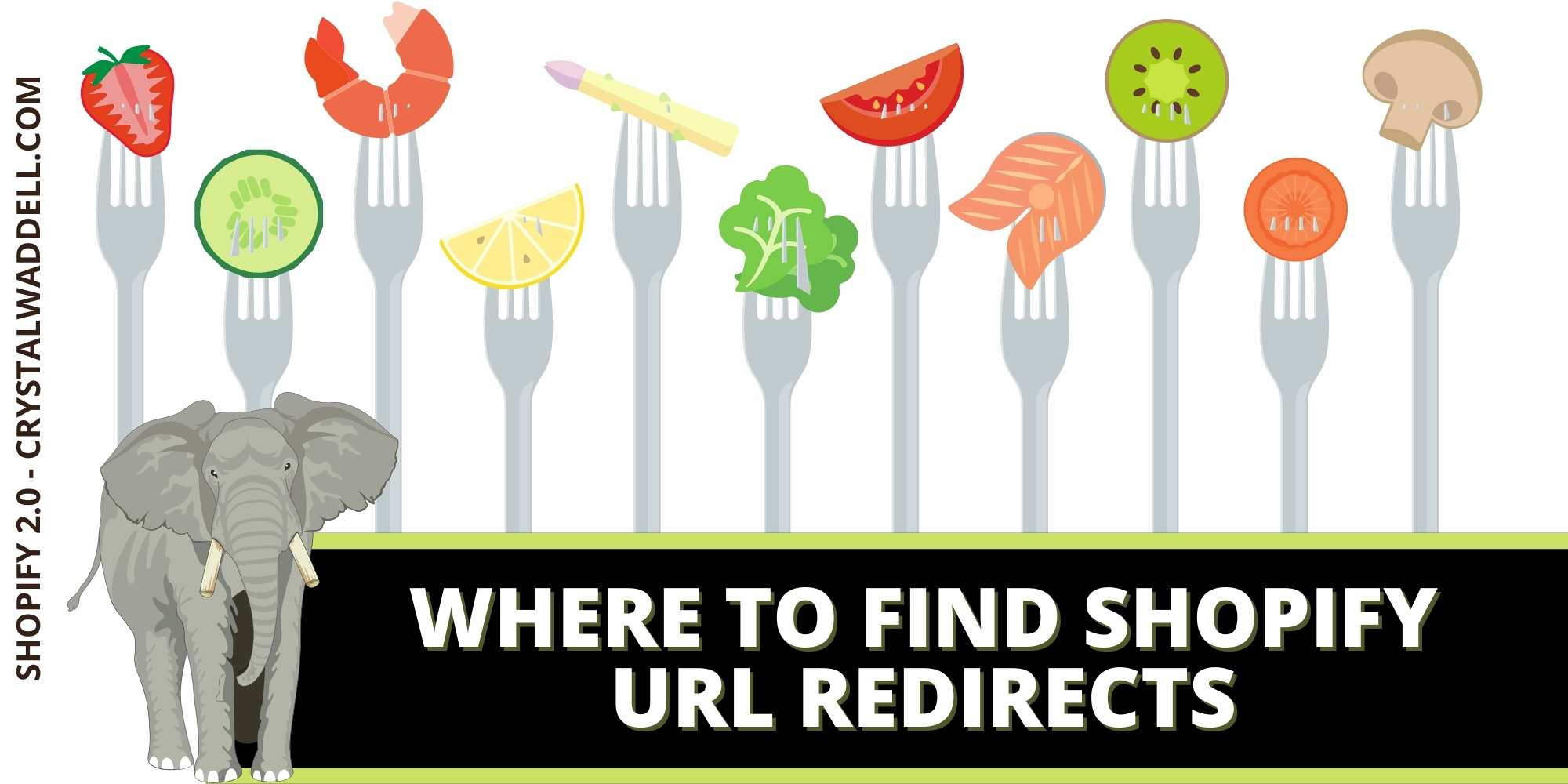
301 redirects play an important role in Shopify.
Redirects direct your organic traffic to the correct web pages.
This is especially important when you're making changes to your website. For instance, renaming or reorganizing pages. These actions can lead to broken links.
Shopify will often give you an option to create a redirect.
Most of the time when you create a new URL within the page builder on Shopify, it's as easy as checking a box.
When you create a 301 redirect, it sends visitors who try to access the old page to the new page.
This ensures that they don't get lost on your website. And also, that they can still find the information they're looking for.
Additionally, 301 redirects also help to improve your website's search engine ranking.
Search engines like Google prefer websites that have them in place. Search engines use redirects as a signal of quality.
What happens if you don't have a 301 redirect? A "broken link" or a 404 page.
I like to have fun with my 404 pages but , they are best to avoid if possible!
41. EDITING MENUS (AND ADDING KEYWORDS)

Yes! You can add keywords to your Shopify menus to help improve your SEO.
This is one of my favorite SEO ninja moves for Shopify stores.
Adding keywords to your menus is a great way to improve your site's SEO.
When you create or edit a menu, enter specific keywords in the Menu Title and Menu Description fields.
These keywords will help Google index your site and rank it higher in search results.
To help you get started, here are some tips for optimizing your Shopify menus for organic search:
Use keyword-rich titles and descriptions for each menu item.
Keep your titles and descriptions brief and easy to read.
Place important keywords near the beginning of titles and descriptions.
42. SHOPIFY SEARCH AND DISCOVERY APP
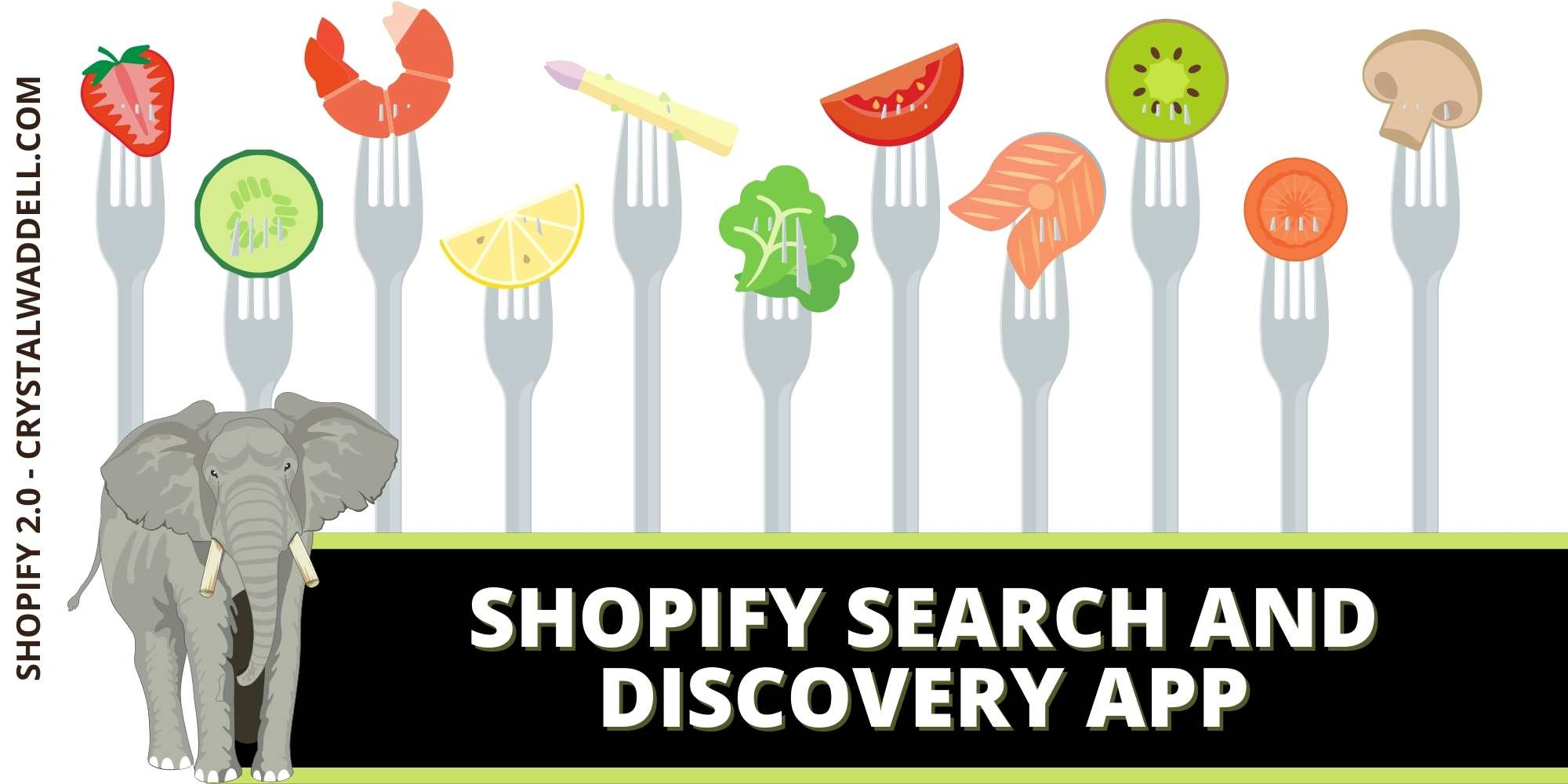
The Shopify search bar has had an impressive upgrade.
The Shopify Search and Discovery App is a powerful tool. The App helps your site visitors find the products they're looking for, faster.
Shopify research has made the distinction between "search" and "discovery".
Search means a customer knows what they are looking to find. Discovery is when a customer happens upon one of your products.
Sounds like Shopify has learned a thing or two from Pinterest!
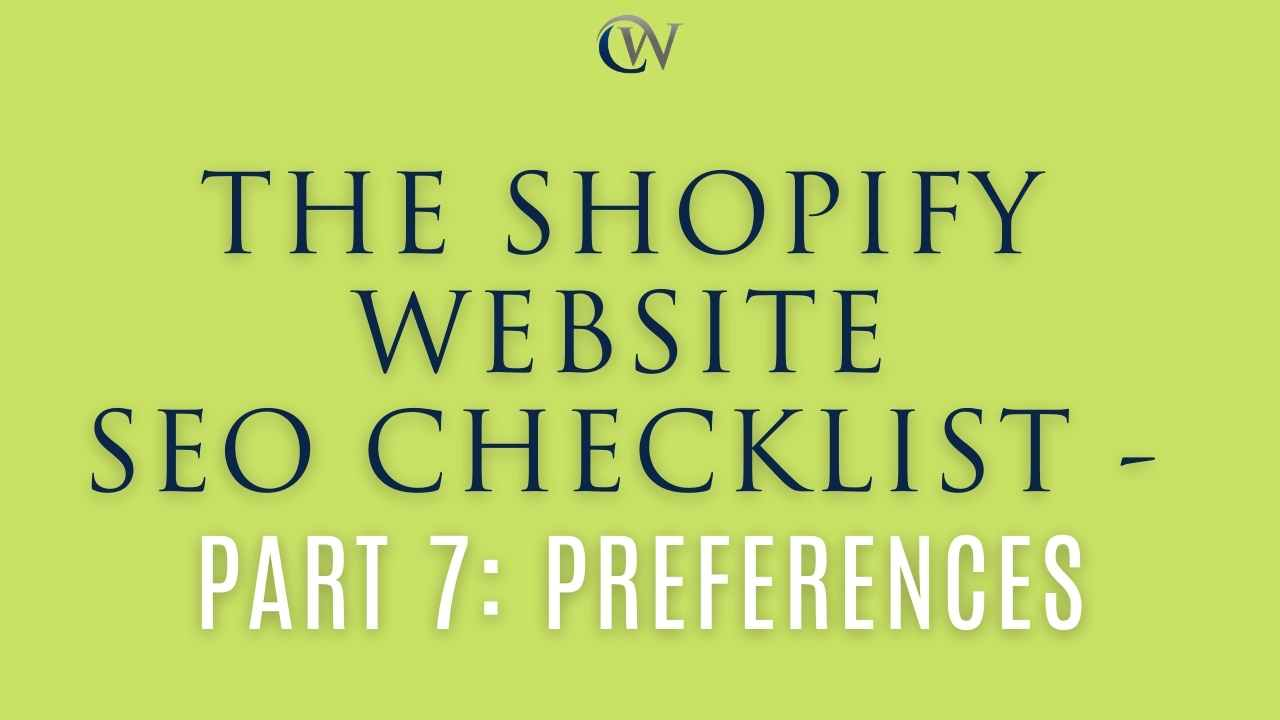
42. HOMEPAGE TITLE
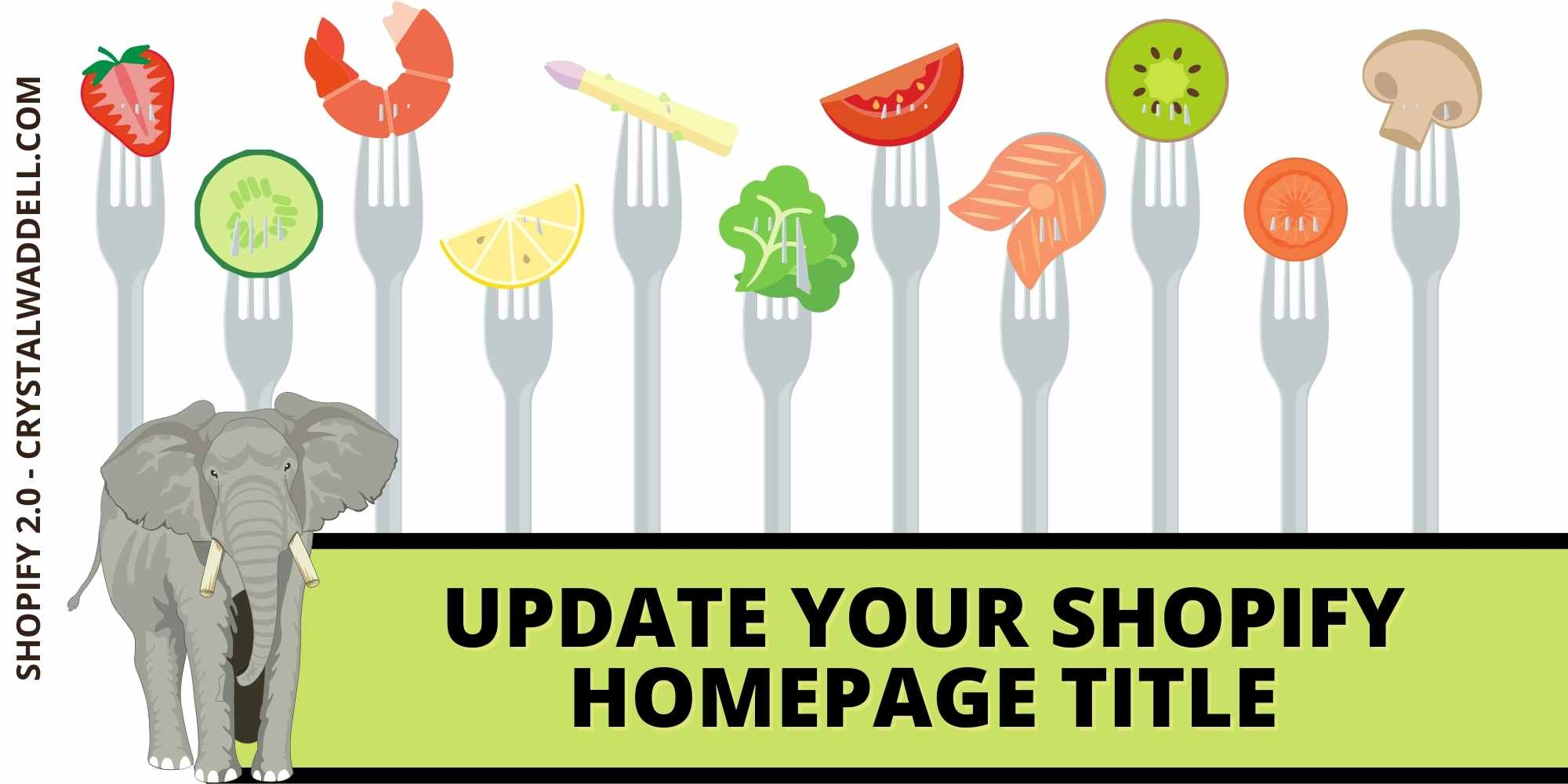
We are in the homestretch of this Shopify SEO guide!
To edit your homepage title, you will need to navigate to the Preferences section of Shopify.
Click Online Store and choose Preferences from the menu.
This is where you can get to the place to add the most important keywords for your website SEO!
43. HOMEPAGE METADESCRIPTION
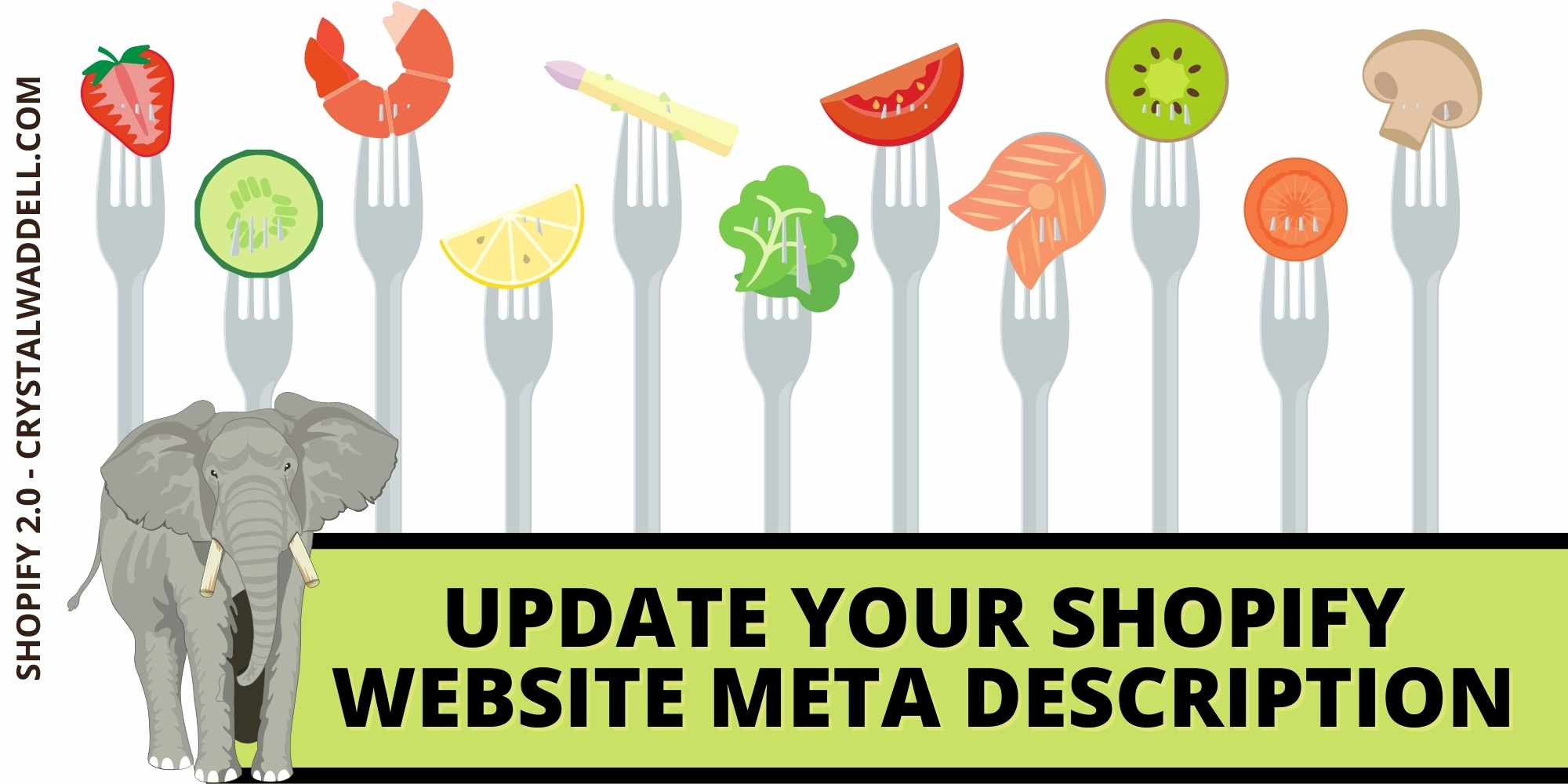
A home page meta description is the short blurb that appears under your website's URL in the SERPs.
They're one of the most important on-page SEO elements, so it's important to get them right!
A good home page meta description should be around 155 characters long. It should contain keyword-rich, relevant information about your business.
You might include keywords like "shoes," "sandals," and "boots" if you sell different types of shoes.
44. SOCIAL SHARING IMAGE PREVIEW
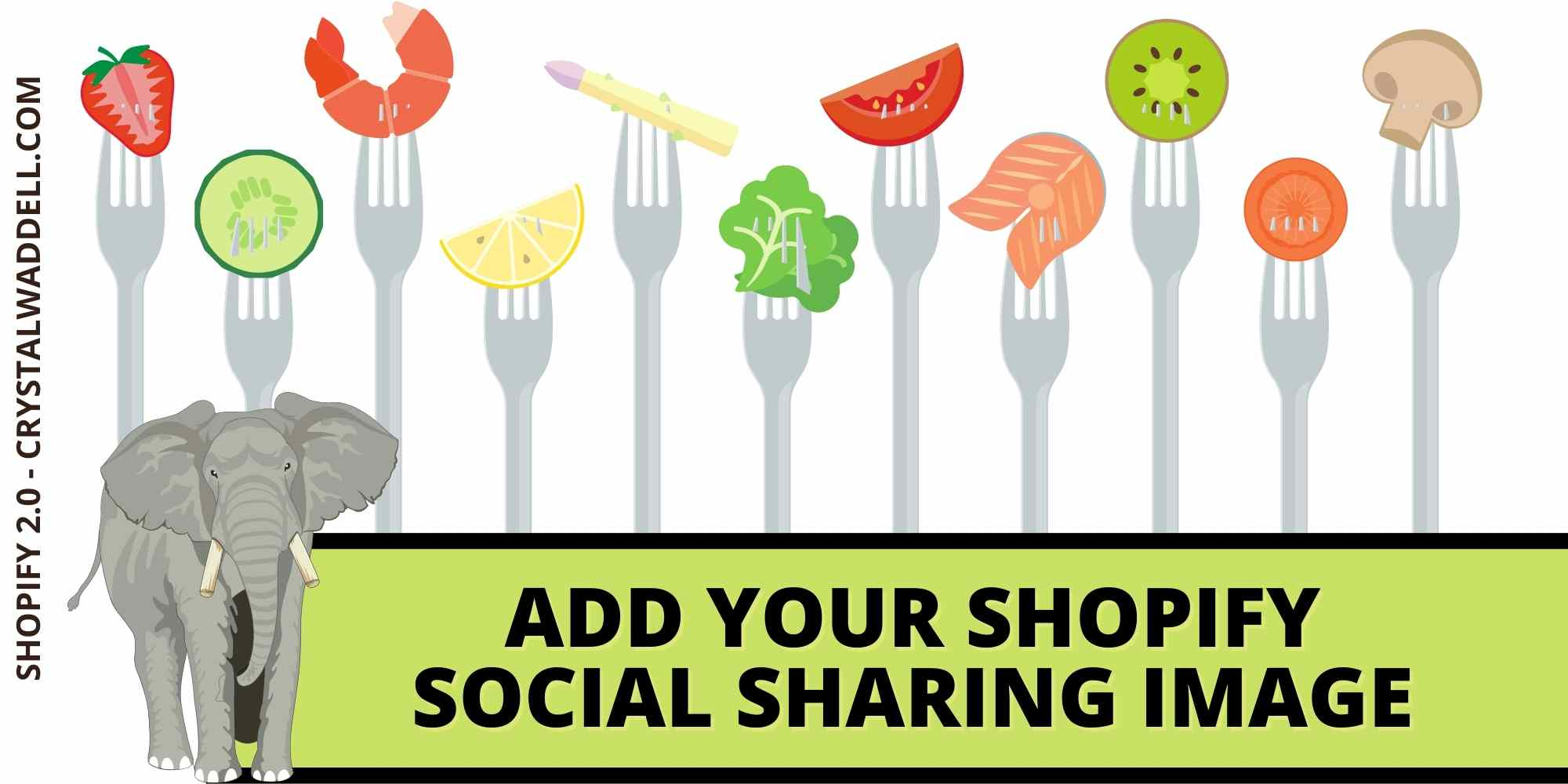
A social sharing image is an image that shows up when someone shares your web pages on social media. Shopify gives you recommended dimensions of 1200 x 628 px.
You can use a site like Canva to create the graphic you want to display on social. Then, Shopify allows you to set a default social sharing image.
This means that whenever someone shares a link from your store, this image shows up.
Pro tip: A fun way I use this is to optimize for the season of the year.
45. GOOGLE ANALYTICS
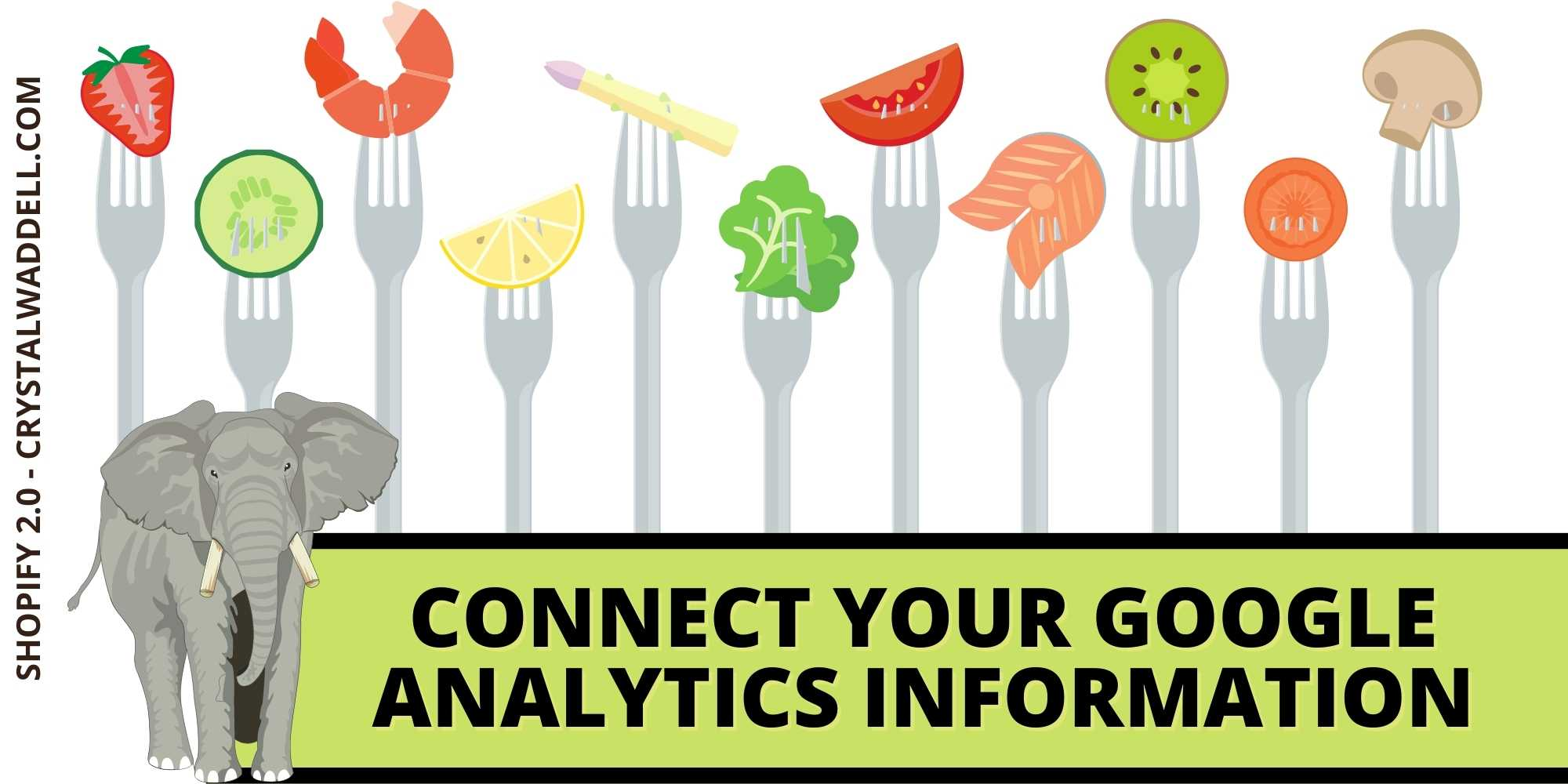
Google Analytics is the gold standard web analytics tool.
Universal Analytics and GA-4 helps Shopify website owners understand how visitors interact with their site.
The key to optimizing SEO tools like Google Analytics? Install them before you feel like your site is ready.
For instance, Bing webmaster tools are a growing resource, and a non-Google product. So is Microsoft Clarity.
These tools provide valuable insights into the behavior of online shoppers.
Google Analytics can help you track your shop's traffic and conversion rates.
GA data allows you to see which products are performing well. As well as which ones need improvement (aka enhanced ecommerce!)
Unfortunately, Shopify doesn't have a specific integration for GA4. This means you must add the coding elements.
Another option is to add Google Tag Manager coding.
It's also important to integrate Google Search Console with Google Analytics. This will give you the best insights to improve your search engine rankings.
46. SPAM PROTECTION
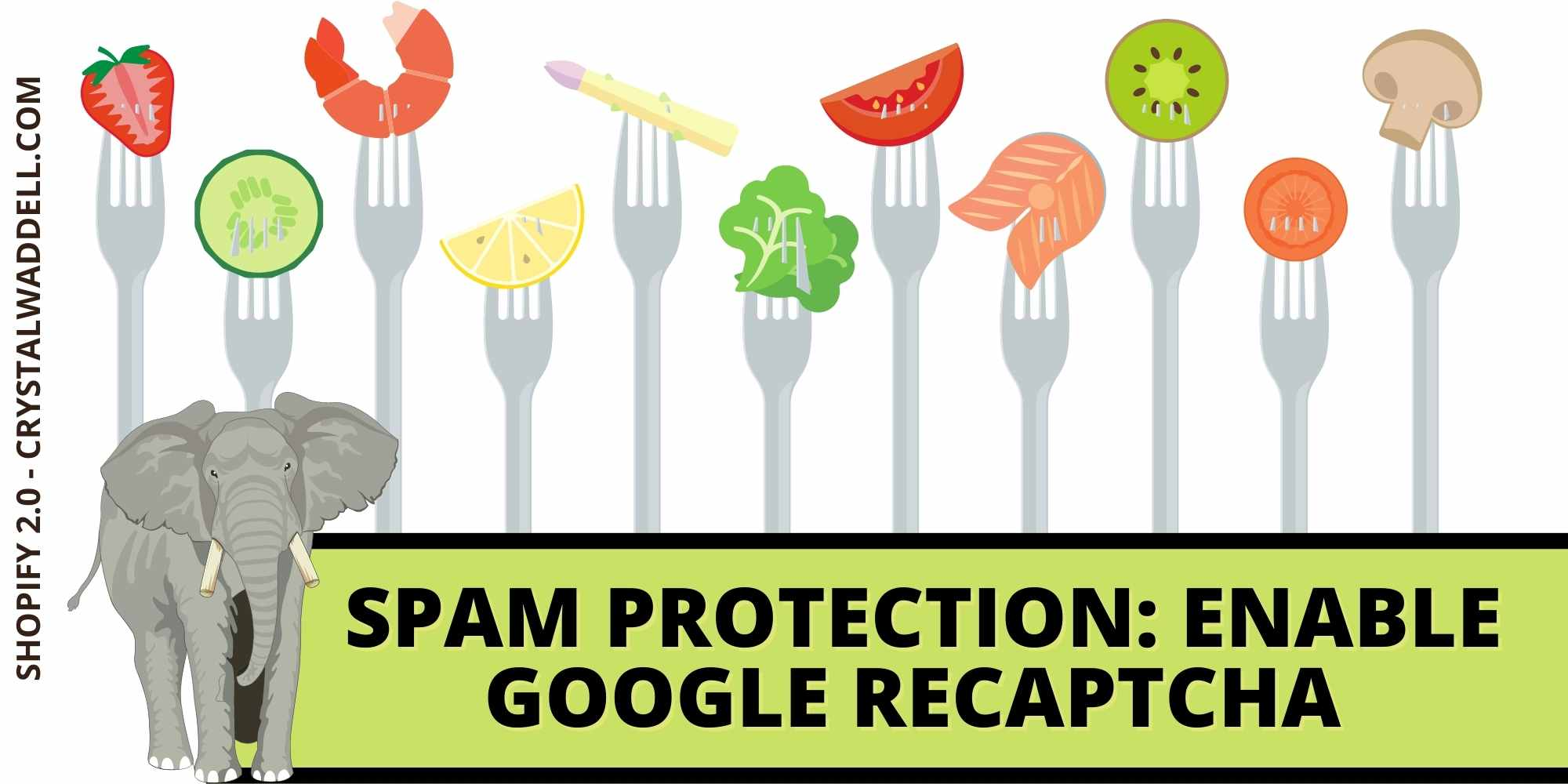
When it comes to Shopify, spam protection is important because it helps to keep your site safe and secure.
Shopify's built-in spam protection filters out malicious emails and bots. These can harm your site or steal your customers' information.
A strong spam protection system protects your Shopify site and maintains customer trust.
FREQUENTLY ASKED QUESTIONS ABOUT SEO FOR shopify
Is SEO good for Shopify?
SEO is a MUST for Shopify owners who want to build a long-term asset!
Don't buy into the lie that your ecommerce store can rely solely on ads. In fact, your ads cost can actually be 40% higher if you have poor SEO on your website.
For those reasons and more, SEO can be a great way to increase traffic to your online store.
By optimizing your site for search engines and using the right keywords, you can attract more potential customers to your shop.
However, it's important to remember that SEO is a long-term strategy and it may take some time before you see results.
If you're looking for immediate traffic, paid advertising may be a better option.
What is schema markup?
Schema markup is a code that helps search engines understand the structure of your website.
This can be helpful for Shopify users, as it can help your store's product pages appear in Rich Snippets in Google search results.
Adding schema markup to your product pages can help give potential customers more information about your products, which can help increase click-through rates and encourage more sales.
Schema markup is automatically integrated in most 2.0 themes.
How do I create SEO for Shopify?
There are a few things you can do to make sure your Shopify store is optimized for SEO.
First, choose a good URL structure. Use keywords in your URLs and keep them short and sweet.
Second, use title tags and meta descriptions. Make sure your title tags are unique and descriptive, and include your target keywords.
Meta descriptions should be clear and concise, making it easy for users to know what your page is about.
Third, use header tags to organize your content. H1 tags for titles ar built into the Shopify structure. When you give your page a title, you also give it an H1 tag.
Use H2 tags for subheadings. This will help both users and search engine crawlers understand the structure of your pages.
Fourth, take advantage of Shopify’s built-in blog feature.
Posting regular blog content is a great way to keep your site fresh and relevant, and it gives you an opportunity to use keywords to attract new visitors.
Finally, make sure your site is mobile-friendly.
With more and more people using their cell phones to surf the web, it’s important to make sure your site is designed for smaller screens.
Shopify makes it easy to create a mobile-friendly version of your site, so there’s no excuse not to.
By following these simple SEO tips, you can help make sure your Shopify store is visible to the people who are looking for what you sell.
Do I need SEO for dropshipping?
Yes, you need SEO for your dropshipping business - in fact, it's essential for driving traffic to your site and growing your sales.
SEO is the process of optimizing your website and content so that you rank higher in search engine results pages (SERPs), helping you to get in front of more potential customers.
And since most people don't scroll past the first page of results, ranking high is essential for getting more traffic and sales from your online store.
Fortunately, optimizing for SEO is relatively simple and inexpensive, and there are plenty of great resources available online to help you get started (starting with this article!)
So if you're not already doing SEO for your shopify store, it's definitely something worth considering.
How does SEO rank in Shopify?
There's no doubt that SEO is important for any ecommerce platform, and Shopify is no exception.
While Shopify has many built-in features to help your store rank well in search engines, there are a few things you can do to give your store an extra boost.
Here are some tips for optimizing your Shopify store for SEO:
1) Use relevant keyword-rich titles and descriptions for your products. This helps search engines understand what your products are about.
Keywords also help potential customers find your products when they're searching for something specific.
A plug-in like Yoast Seo for shopify can help you get started.
2) Make sure your website is fast and responsive. Search engines penalize sites that take too long to load, so it's important to make sure yours is loading as quickly as possible.
Connecting your domain to Google search console will give you insights for your keyword research strategy and help you fix any site speed issues.
But wait! There's more [SEO resources!]
That's the end for now but please visit again! I will be updating this article with extra content and videos.
Are there any SEO features you would like to see more of in future articles?
I’d also love to hear about your experiences with Shopify 2.0 themes – which is your favorite? Email me here!
If you think someone else might find this post helpful, please share it on Twitter or Facebook!
Thank you for reading and have fun while you SEO-ify your Shopify!






